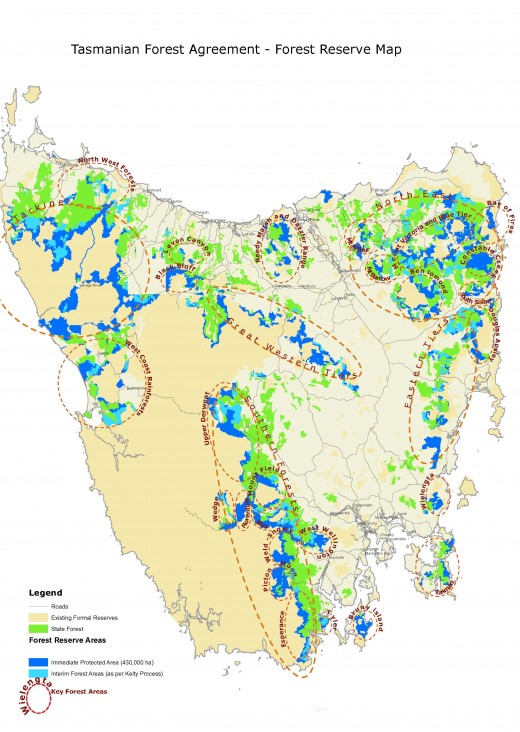Posts Tagged ‘Woodchipping Tasmania’
Thursday, December 15th, 2011
“The moment one definitely commits oneself, then providence moves too. All sorts of things occur to help one that would never otherwise occurred. A whole stream of events issues from the decision, raising in one’s favor all manner of unforeseen incidents and meetings and material assistance which no man could have dreamed would have come his way. Whatever you can do or dream you can, begin it. Boldness has genius, power and magic in it. Begin it now.”
~ attributed to Goethe.
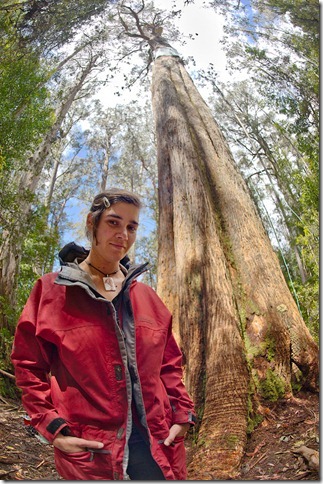 Miranda – Defender of Tasmania’s Forest Heritage
at the foot of ‘The Observer Tree‘
Mount Mueller Forest, Styx Valley, Tasmania
Miranda – Defender of Tasmania’s Forest Heritage
at the foot of ‘The Observer Tree‘
Mount Mueller Forest, Styx Valley, Tasmania
.
One young Tasmanian woman, charged with a deep commitment to her natural island heritage, continues to be prepared to do more to protect Tasmanian old growth forests than most Tasmanians. Miranda Gibson of Still Wild Still Threatened is certainly prepared to do more than the current (read ‘temporary‘) Premier of Tasmania Lara Giddings, and more than the current (read ‘temporary‘) Prime Minister of Australia, Julia Gillard, who have quickly turned their backs on Tasmanians to more populist party-political issues of the day.
.
 Tasmania’s Forest Wars
– what the Intergovernmental Agreement is supposed to resolve. Tasmania’s Forest Wars
– what the Intergovernmental Agreement is supposed to resolve.
.
Gillard and Giddings in breach of Tasmania’s 2011 Forest Agreement
.
Tasmanians are condemning government delinquency on meeting the conservation goals contained in the Gillard Labor Government’s Forests Intergovernmental Agreement (IGA) signed and promised to all Tasmanians in Launceston on 7th August 2011.
 Giddings and Gillard
– hollow Labor promises Giddings and Gillard
– hollow Labor promises
.
IGA Clause 25 states:
.
‘The State will immediately place the 430,000 ha of native forest identified in Attachment A (other than any areas which are not State forest) from the 572,000 ha nominated by ENGOs through the Statement of Principles process, into Informal Reserves.’
.
IGA Clause 27 states:
.
‘In the event that Forestry Tasmania reports that it cannot meet contractual requirements from production resources outside the nominated 430,000 ha the Governments will undertake the following steps. First, an independent expert will be jointly appointed by the Governments to review scheduling and other relevant data and attempt to reschedule harvesting activities so as to meet the requirements of contracts and maintain the interim protection of 430,000 ha. In the event that the independent expert concludes it is impossible to achieve this, the Commonwealth will compensate the contract holder for the value of lost profits and unavoidable costs.’
.
Gillard’s fly-in to Launceston on 7th August 2011 to sign and celebrate the Tasmanian Forests Intergovernmental Agreement with Labor mate Giddings was not a mere plaque unveiling, it was a Tasmanian landmark agreement to provide certainty for Tasmania’s forestry industry, support local jobs and communities, and protect the state’s ancient forests. It deserves the respect of commitment and follow through on promise.
On the one hand it has funded Forestry and its associated families hundreds of millions and with a dignified exit from logging and transition to alternate trades. On the other hand Gillard’s Forest Agreement guarantees protection for Tasmania’s natural but threatened heritage – its most iconic ancient forests, immediately placing 430,000 hectares of iconic old growth native forest into informal reserve – the Styx, Upper Florentine, Huon, Picton and Weld Valleys and the Great Western Tiers, Tarkine and Wielangta.
.
Gillard’s promise made to the Australian people (Prime Minister Gillard’s official website):
.
‘These forests will not be accessed for harvest while verification takes place.‘.
Well, verification is still taking place. And Bill Kelty, who brokered the deal, seems to have run to the hills.
Such a landmark State-wide agreement that promises a ‘strong foundation‘ is hollow if the leadership waddles off to be distracted by other issue so the day, without the committed delegation of trusted lieutenants to see through on implementation. Predecessor PM Kevin Rudd failed classically on the implementation phase of his policy – insulation being his and Garrett’s multi-million dollar incompetent legacy.
“The Australian and Tasmanian governments are taking too long to implement the intergovernmental agreement. If they can get their act together to offer contractors exit packages then they can honour the conservation agreement as well.” Greens Senator Bob Brown has said. “Four months later not one hectare has been protected and Forestry Tasmania continues to fell these magnificent trees as fast as they can put the roads in. All up, more than 10km2 of our wild forests will be destroyed“, Greens Senator Brown said.
All political leaders, while dancing on mountains of power and influence, pragmatically realise that their time in office is temporary. Status quo is not a characteristic of modern democratic politics. What matters most in political careers is legacy. Australia’s current Prime Minister Julia Gillard is starting to stare that legacy in the face as she allows Premier Lara Giddings to breaking the $276 million promise by backing Forestry Tasmania’s current logging of the 430,000 hectares of old growth forest protected under the Gillard Government’s Agreement.
.
Tasmanian Betrayal
.
Gillard and Giddings have allowed Forestry Tasmania to log the protected 430,000 hectares, ignoring the prescribed compensation requirement. Gillard and Giddings have blatantly reneged on their core promise in the Agreement to cease logging and to protect these forests. Gillard and Giddings have betrayed the Tasmanian and Australian people. They have no mandate to stay in power. Their broken promises are to be their legacies.
.
“Those who cannot work with their hearts achieve but a hollow, half-hearted success that breeds bitterness all around”
~ Abdul Kalam, President of India (b.1931)
 Styx Valley Giants being massacred by State logger ‘Forestry Tasmania’ Styx Valley Giants being massacred by State logger ‘Forestry Tasmania’
.
Tasmania sells itself as ‘the natural state’. But there is a gap between rhetoric and reality as logging of old-growth forests continues – to international dismay.
“And they have these big logs, and you just know they are coming from old-growth forests…I don’t think I could take living there and seeing them every day knowing (the trees) are going mostly to woodchips.” ~ Larraine Herrick or Tumbarumba, Snowy Mountains, New South Wales.
But the Styx has been, and (is continuing) to be, logged by the timber industry in a state in which questions have been repeatedly raised about whether cronyism, corruption and deception underlie the management of forests. Only discovered in 2002, El Grande was a Eucalyptus regnans with a 19-metre circumference. Last autumn (2003), it was killed when a regeneration burn went wrong. Its demise helped fuel a midwinter protest that drew more than 2000 people to the Styx Valley. There, The Wilderness Society and Greenpeace began a tree-sit, 65 metres up a threatened giant eucalypt called Gandalf Staff.
.
[Source: ‘Tasmania: seeing the wood but not the trees‘, by Melissa Fyfe and Andrew Darby, The Age Newspaper, 20040313, ^http://www.theage.com.au/news/science/tasmania-seeing-the-wood-but-not-the-trees/2004/03/13/1078594604573.html]
.
 ‘El Grande’
Australia’s largest tree burned to death in 2003 by Forestry Tasmania’s incompetence ‘El Grande’
Australia’s largest tree burned to death in 2003 by Forestry Tasmania’s incompetence
.
Tasmanian forests activist organisation Still Wild Still Threatened have called on the Federal and State governments to honour a $276 million forest deal made on 7th August 2011.
“This deal has already seen $35 million delivered to Forestry Tasmania and Gunns Ltd. without protecting a single tree” said Still Wild Still Threatened spokesperson Ali Alishah.
“It is clear that by backing Forestry Tasmania’s destructive practices within the identified 430,000 ha area of high conservation value native forest, the State and Federal Governments are in direct violation of Clauses 25 and 27 of their own Inter Governmental Agreement.” said Mr. Alishah.
.
.
.
The Observer Tree

Miranda Gibson on top of The Observer Tree
Totally committed to Tasmanian Forests,
unlike Gillard and Giddings hollow words.
.
Still Wild Still Threatened have this week launched a new tool in the fight to protect Tasmania’s forests today, unveiling the ‘ObserverTree‘, a 17-storey high tree sit and media centre equipped with the technology to record footage of logging operations and stream these images live to the world via the internet.
The Observer Tree is located in the Styx Forest below Mt Mueller, in Tasmania’s western wilderness, part of the 430,000 ha of forest that was supposed to receive immediate protection under the federal-state agreement on forests (the IGA). The Observer Tree is situated at the head of a section of Styx Forest currently targeted for logging by Forestry Tasmania.
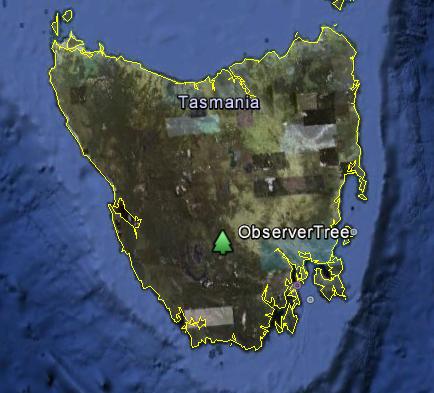 ‘Observer Tree’ location
^http://observertree.org/2011/12/15/observertree-on-google-maps/
‘Observer Tree’ location
^http://observertree.org/2011/12/15/observertree-on-google-maps/
.
Teacher, author and forest activist, Miranda Gibson, has vowed to occupy the tree-platform continuously, until real protection is secured for Tasmania’s forests. Ms Gibson will maintain a daily blog and upload video updates during her stay in the tree, documenting the struggle to protect Tasmania’s forests to concerned people all over the globe.
‘We have used the internet to connect this spectacular patch of threatened Tasmanian forest to the world. The Observer Tree will transmit images and information about the value of the thousands of hectares of forest that remain threatened if Julia Gillard does not keep her word. People across Australia and the globe will have the opportunity to view bear witness to the wasteful destruction of these forests and hear from the people fighting to protect them,’ said Ms Gibson.
For the first time their actual logging will be broadcast live internationally via the web.
Website: ^http://www.observertree.org
Facebook: ^http://www.facebook.com/#!/pages/ObserverTree/152795598158969
Download Google Earth (93MB): GoTo: ^http://www.google.com/earth/download/ge/
.
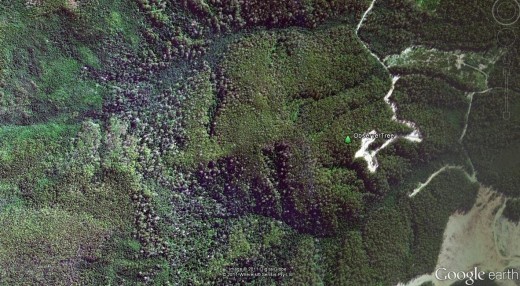 Google Earth’s satellite image of the Observer Tree in dense old-growth, adjacent to Forestry Tasmania’s fresh logging road
(click photo to enlarge) Google Earth’s satellite image of the Observer Tree in dense old-growth, adjacent to Forestry Tasmania’s fresh logging road
(click photo to enlarge)
.
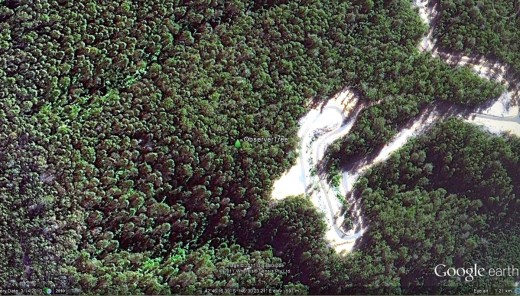 Close up image
(click photo to enlarge) Close up image
(click photo to enlarge)
.
.
Monday: Forestry Tasmania attacks the Styx Forest
.
On Monday 12th December 2011, State forest ‘nazi logger’, Forestry Tasmania, under the command of District Officer (Gauführer) Steve Whitely, rolled in its contracted ‘ecodeath-squad’ into the western end of the magnificent Styx Valley. The targeted forest area is situated at the base of Tasmania’s prominent and wild Mt Mueller on the border of the World Heritage Area. It is situated about 25 km west of the infamous logging town of Maydena.
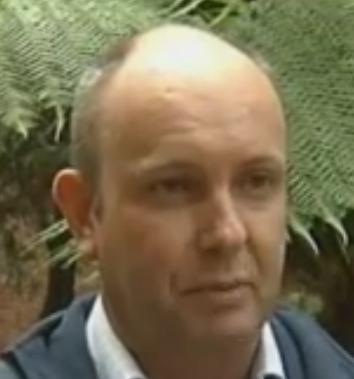 Directing the logging – Forestry Tasmania’s Steve Whiteley
[Source: Southern Cross Television, 20111214]
Directing the logging – Forestry Tasmania’s Steve Whiteley
[Source: Southern Cross Television, 20111214]
.
In true forest nazi style, Forestry Tasmania’s targeted forest area is branded as coupe ‘TN 044B‘.
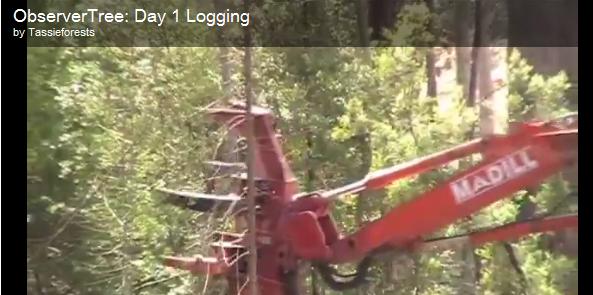 Logging Nazi in and destroying the Styx Valley Forest
Monday 12th December 2011, in direct breach of Prime Minister Gillard’s Forest Agreement. Logging Nazi in and destroying the Styx Valley Forest
Monday 12th December 2011, in direct breach of Prime Minister Gillard’s Forest Agreement.
.
This ‘Madill’ feller buncher was getting well stuck into the Styx Valley last Monday morning just below the Observer Tree. The hydraulic arm clamps onto the trunk of the tree while a cutting mechanism severs the tree at the stump. The machine then lifts the tree, lowers the tree into a horizontal position, and drops the tree on a bunch of logs piled on the ground. The industrial machinery has all the efficiency of a Nazi death factory.
.
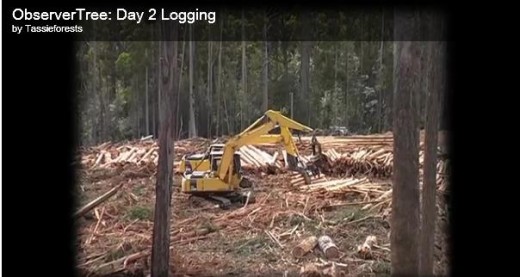
.
Foresty Tasmania is operating in direct contradiction of IGA Clauses 25 and 27. The coupes within the 430,000 ha of high conservation value forest are not to be logged under any condition. The IGA prescribes that relevant customers and contractors are to be granted compensation and million have been set aside for this purpose. Foresty Tasmania under Gauführer Steve Whitely is out of control. He is driving ecological apocalypse in Tasmania’s southern forests. He has become a Walter E. Kurtz.
 Walter E. Kurtz – unhinged, his methods unsound. Walter E. Kurtz – unhinged, his methods unsound.
.
Tags: Abdul Kalam, activist, Bill Kelty, El Grande, Forestry Tasmania, Gandalf, Google Earth, Inter Governmental Agreement, Julia Gillard, Lara Giddings, Maydena, Mount Mueller, nazi logger, Observer Tree, old growth forest, Still Wild Still Threatened, Styx Forest, Styx Valley, Tasmania, Tasmanian Betrayal, Tasmanian Forests Intergovernmental Agreement, The Observer Tree, Woodchipping Tasmania
Posted in Tasmania (AU), Threats from Deforestation, Threats from Weak Environmental Laws, Threats to Wild Tasmania | No Comments »
Add this post to Del.icio.us - Digg
Sunday, October 2nd, 2011
Just back from a visit to Tasmania’s majestic world heritage Styx Valley, the editor is shocked at the indiscriminate forest ecocide by Forestry Tasmania ~ a Martin Bryant on the loose slaughtering Tasmania’s irreplaceable ancient forest heritage.
 Tasmania’s ancient Styx Forest ~ ancient Myrtles, Celery Top Pines, Blackwoods, Regnans, Sassafras and the wildlife habitat they support…being irreversibly clear-felled and incinerated hectare by hectare by Lara Giddings’ ‘Forestry Tasmania’
[Photo taken on 28th September 2011 by Alan Lesheim Photography]
(click photo to enlarge, then click to enlarge again) Tasmania’s ancient Styx Forest ~ ancient Myrtles, Celery Top Pines, Blackwoods, Regnans, Sassafras and the wildlife habitat they support…being irreversibly clear-felled and incinerated hectare by hectare by Lara Giddings’ ‘Forestry Tasmania’
[Photo taken on 28th September 2011 by Alan Lesheim Photography]
(click photo to enlarge, then click to enlarge again)
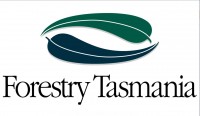 . .
Forestry Tasmania ~ the mind of a ‘forestpath’:
 Martin Bryant ~ the 1996 mass murderer of Tasmania
[Read More]
Martin Bryant ~ the 1996 mass murderer of Tasmania
[Read More]
Like this mentally disturbed misfit, who as a child cut down trees on a neighbour’s property and received an air rifle for his 14th birthday; Forestry Tasmania, has been reared by successive Tasmanian governments creating a subsidised cushion around it that throughout its existence has protected it from reality ~ economic reality, social reality , ecological reality.
Tasmanian Government artificial cushions have acted as constraints that impeded or at least diffused, and gave an outlet for, its most obsessive tendencies ~ clearfell and bush arson. ‘Left to its own mounting frustrations, angers, resentment of rejection and social misunderstanding’. Forestry Tasmania’s current clear-felling rampage ranks among the deadliest for Tasmanian old growth forests in the 21st Century.
.
[Adapted from the Sydney Morning Herald article ‘A dangerous mind: what turned Martin Bryant into a mass murderer?’, by Robert Wainwright and Paola Totaro, 20090427, ^http://www.smh.com.au/national/a-dangerous-mind-what-turned-martin-bryant-into-a-mass-murderer-20090427-ajk4.html]
.
Forestry Tool of the Trade:
 A Doosan Harvester
– a Japanese company, supplying equipment to more efficiently destroy Tasmanian old growth for woodchips back to Japan, or more so China nowadays.
Forestry is stihl about jobs? ~ pull the other one. A Doosan Harvester
– a Japanese company, supplying equipment to more efficiently destroy Tasmanian old growth for woodchips back to Japan, or more so China nowadays.
Forestry is stihl about jobs? ~ pull the other one.
 ‘The Doosan Credo focuses on our responsibilities to people, business and society.
We are confident that by fostering talented people, honesty, transparent business management, and ceaseless innovation, that we will become a “Proud Global Doosan.”
.
[Source: ^http://www.doosan.com/en/about/the_doosan_way.page?]
‘The Doosan Credo focuses on our responsibilities to people, business and society.
We are confident that by fostering talented people, honesty, transparent business management, and ceaseless innovation, that we will become a “Proud Global Doosan.”
.
[Source: ^http://www.doosan.com/en/about/the_doosan_way.page?]
.
Pull the other one!
.
 The Forester Phallic
~ do foresters stihl give their sons chainsaws on their 14th birthday?
The Forester Phallic
~ do foresters stihl give their sons chainsaws on their 14th birthday?
.
.
Tags: Doosan, forest ecocide, Forest Holocaust, forester phallic, Forestry Tasmania, loggers, Martin Bryant, mind of a forestpath, Stihl woodchipping old growth, Styx Big Tree Reserve, Styx Forest, Styx Valley, Woodchipping Tasmania
Posted in Tasmania (AU), Threats from Deforestation, Threats to Wild Tasmania | No Comments »
Add this post to Del.icio.us - Digg
Saturday, September 24th, 2011
‘Leave No Trace’.. is an internationally-accepted way of minimising impacts on the places we visit, no matter how we choose to experience them. Applying the principles of Leave No Trace can help ensure the protection of Tasmania’s irreplaceable wilderness and heritage for the future.’
~ Leave No Trace Australia [^http://www.lnt.org.au/programs/7-principles.html]
.
.
‘And it’s whispered that soon if we all call the tune
Then the piper will lead us to reason.
And a new day will dawn for those who stand long
And the forests will echo with laughter’.
.
– Led Zeppelin, Led Zeppelin IV
.
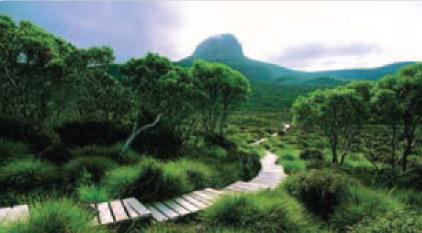 ‘As you visit this special country, please take care to Leave No Trace!’ ‘As you visit this special country, please take care to Leave No Trace!’
(Click this image, then allow the music to play, while you scroll through this article)
.

.
‘Outdoor Ethics’?… do unto Nature as you would have Nature do unto you.
.
Recognise that loud supercilious tourists attract local repulsion, like raw sewage being pumped into a community’s drinking water.
.
.
.
Then there is the Logging World…
.
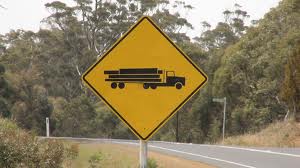 “I am the way and the truth and the life.
No one comes to log except through me.” “I am the way and the truth and the life.
No one comes to log except through me.”
.
A “logger” logs
I am that “logger”
Therefore I log
Therefore I am.
 . .
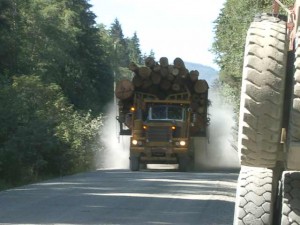 Logging Canada Logging Canada
.
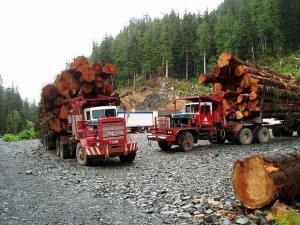 Logging British Columbia Logging British Columbia
.
 Logging Oregon ~ that’s a ‘single rider’ Logging Oregon ~ that’s a ‘single rider’
.
 Logging Tasmania like there’s no tomorrow..and they were right Logging Tasmania like there’s no tomorrow..and they were right
.
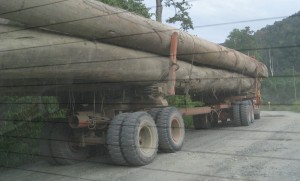 Logging Borneo
~ a rearward perspective Logging Borneo
~ a rearward perspective
(click to enlarge)
.
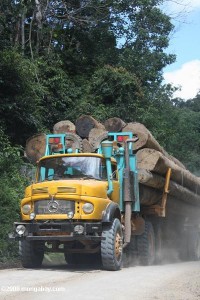 Logging more of Borneo Logging more of Borneo
.
 Logging Gabon, west African rainforest Logging Gabon, west African rainforest
.
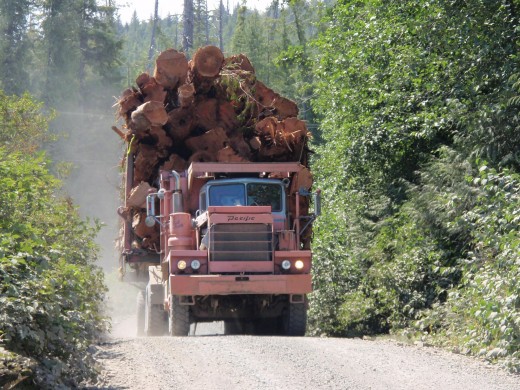 Get out of my bloody way!
It’s logging season and they could change the laws next week! Get out of my bloody way!
It’s logging season and they could change the laws next week!
.
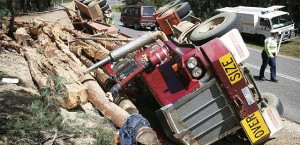 Quality Control in Tasmanian Logging Quality Control in Tasmanian Logging
.
 Triabunna’s Forest Death Camp Triabunna’s Forest Death Camp
.
 Burnie’s Forest Death Camp Burnie’s Forest Death Camp
.
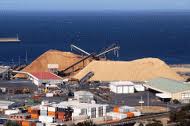 Woodchip Town
~ home of loggers…twenty eight generations at least! Woodchip Town
~ home of loggers…twenty eight generations at least!
.
.
‘Ta Ann’: Forestry Tasmania’s Malaysian Veneer
.
Desperate to find new buyers to justify logging Tasmanian native forests, Forestry Tasmania has sought its Malaysian Solution. The propaganda was that ‘the mills will process regrowth logs only’ and will create local jobs. But after investing tens of millions in two veneer mills, Malaysian logger, ‘Ta Ann’ is now pressuring the government to give them access to Tasmanian native forests to feed the mill monsters. So it was all a veneer of truth.
It all screams of the 1916 ‘Zinc Bargain‘ when the Tasmanian government approved a hydro bulk power contract for the Amalgamated Zinc smelter. By the 1930s, the smelter was swallowing up 3/4 of the Hydro Electric Departments electricity output. Dodgy government deals for big foreign corporates to exploit Tasmania’s native forests. Indeed, Newood mill in Huon built by John Holland the Huon Wood Centre Infrastructure
John Holland has reached practical completion of the stage 2 infrastructure works on the Huon wood centre site required the installation by Transend of a 110kV transmission spur to divert hydro-electrical power from Castle Forbes Bay to power Ta Ann’s Huon mill. .
‘In 2005, Forestry Tasmania was successful in securing the commitment of the Malaysian-based timber company, the Ta Ann Group, to develop two rotary veneer peeling mills in Tasmania at a cost of $65 million. The mills will process regrowth logs only [ed: famous last words] and are to be located ‘in the forest.’
“A rotary veneer mill is an efficient means of adding value to short logs that are not useable for higher-value purposes such as sawmilling,” ~ Bob Gordon (Managing Director of Forestry Tasmania)
In 2007, the first of the mills opened in the Huon district and the second, at Smithton in the North West is currently under construction. When fully operational, the two mills are expected to employ 120 Tasmanians. [ye ol’ jobs lure]
Now many regrowth logs that were previously classified as pulpwood are suitable for the manufacture of rotary veneer for construction grade products. Through Forestry Tasmania’s partnership with Ta Ann, up to 25% of wood that was previously chipped is now ‘peeled’ here in Tasmania for higher value veneer production.’ [Source: ^http://www.forestrytas.com.au/regional-dev]
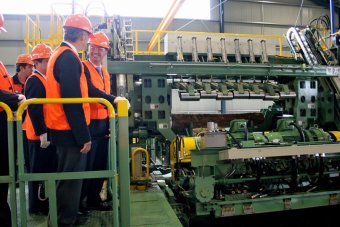 Politicians froth at the prospect of launching anything in front of the media
..here Tasmanian then Premier David Bartlett launching ‘the veneer’ of the Veneer Mill in Smithton in 2008 – ‘plantations only’
. Politicians froth at the prospect of launching anything in front of the media
..here Tasmanian then Premier David Bartlett launching ‘the veneer’ of the Veneer Mill in Smithton in 2008 – ‘plantations only’
.
.
‘The company expects the mill will employ 50 people once it reaches full production. Construction on the $35 million rotary peel mill began in April and last month the company exported its first shipment of veneer to Malaysia.
Today’s symbolic opening was attended by the mill’s Malaysian backers, including the Ta Ann Chairman Datuk Hamed Sapawi, who says Tasmanian eucalypt veneer is particularly well regarded on international markets.
Ta Ann’s first Tasmanian mill in the state’s south began production last year, with the Smithton mill bringing the company’s total investment in Tasmania to $70 million.
Mr Bartlett says the two mills add significant value to timber that would have otherwise been exported as wood chips.’
[Source: ‘Veneer mill officially online’, ABC, 20081128, ^http://www.abc.net.au/news/2008-11-28/veneer-mill-officially-online/222334]
.
 Logging Mogul, Abdul Hamed Sepawi
Malaysian millionnaire boss man and logger pay master – owner of multinational logger ‘Ta Ann’ Logging Mogul, Abdul Hamed Sepawi
Malaysian millionnaire boss man and logger pay master – owner of multinational logger ‘Ta Ann’
.
Sepawi started Ta Ann as a trading firm and now it’s a timber conglomerate with more than 3,000 employees. Ta Ann invests in property development through listed Naim Holdings, which he chairs. Petrol giant Petronas awarded a Ta Ann subsidiary and partner a $780 million deal late last year to build an oil and gas terminal in Kimanis on Borneo.’
But ‘Australian activists are wondering how the Ta Ann Group managed to develop powerful political links in Tasmania. The multi-million-dollar Sarawakian business concern, Ta Ann Group, has managed to secure a grant from the Australian government to invest in a wood veneering factory in Tasmania. Astonished observers and environmentalists, however, are wondering why the Australian government would pay the Sarawak Chief Minister Taib Mahmud-linked company to strip their forest?
Ta Ann is run by Taib’s cousin and well-known proxy, Hamid Sepawi. Sepawi owns a third of the company. According to the Green Party, thus far no satisfactory answer has been provided.
When the project was awarded to Ta Ann, it was with the hope that it would breathe life into a struggling industry.
Ta Ann, when it opened the project, promised that the project would would rely on plantation forests and not extract wood from Tasmania’s remaining high conservation value forests.
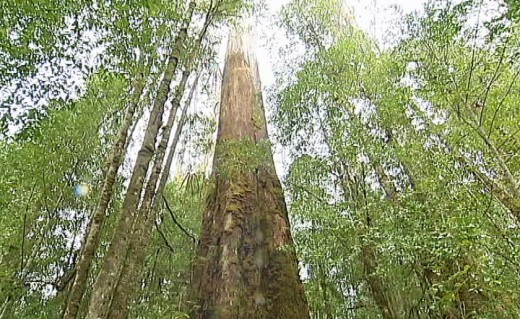 Stihl logged – Tasmanian Native Forests
“Tasmanian eucalypt veneer is particularly well regarded on international markets” ~ Sapawi. Stihl logged – Tasmanian Native Forests
“Tasmanian eucalypt veneer is particularly well regarded on international markets” ~ Sapawi.
.
Tasmania’s primary jungle has been classified as “high conservation value forests”. But recent developments have revealed otherwise. Ta Ann is now pressuring the government to give them access to primary jungle because the quality of plantation wood is not sufficient for their factory and they are demanding hardwood from the jungle.
Environmental group Huon Valley Environment Centre’ spokesman Jenny Weber said the Tasmanian government and Ta Ann were locked in logging the native Tasmanian forests.
“The Tasmanian government and Ta Ann are locking in the logging of native forests to meet a wood supply contract till 2027.
“High conservation value forests are being lost to feed Ta Ann’s mill, when they should be in a moratorium now,” she said.
.
Protests met with contempt
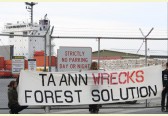 . .
Weber and several activists yesterday boarded a Ta Ann boat laden with wood taken from Tasmania’s primary jungle. They climbed to the top of the boat’s crane tower and chained themselves to it in a bid to draw attention to Ta Ann’s greedy plunder of their own forest.
The protesters are not alone in their anti-logging stance. There has been similar protests and actions like this one in the past, especially in the port areas. These protests have been met with strong-armed tactics and contempt by the authorities.
Earlier this year, the Tasmanian Port Authority announced a 50-metre exclusion zone around all vessels exporting wood chip and veneer. The move is seen as an attempt to prevent protests from holding up Ta Ann’s exports.
There is an overwhelming view among Australians that all logging of primary jungles should be stopped.
Much curiosity has risen as to how this Taib-linked company managed to develop such powerful political links in Tasmania, which is considered to be Australia’s remotest region.
The latest campaign in Tasmania against Ta Ann is a sign of the developing international awareness of Taib and how his greedy pacts with timber tycoons has stripped the Sarawak forest bare.
He and his cronies have spread their tentacles abroad, engaging in plunder across the world’s few remaining areas of virgin jungle.
Tasmania is developing a strong movement to prevent that from happening in its region.
Tasmanian environmentalists now join a legion of other activists across the globe who are against the logging of the world’s remaining forests and the injustices meted out to the indigenous communities in Sarawak and elsewhere.
.
[Source: ‘Why’s Australia ‘paying’ Taib-linked group?‘, 20110719, by Clare Rewcastle Brown, founder/editor of Sarawak Report,^http://hornbillunleashed.wordpress.com/2011/07/19/20969/]
.
.
.
Forestry Tasmania’s Chinese Solution
 Tasmania’s Weedy Sea Dragon
… appropriated for Chinese gain over Tasmania and Tasmanians ~ wake up! Tasmania’s Weedy Sea Dragon
… appropriated for Chinese gain over Tasmania and Tasmanians ~ wake up!
.
‘Forestry Tasmania is always seeking new markets for the Tasmanian forest industry.For example, it has established a new brand in China to promote ‘sustainably harvested‘ Tasmanian peeler logs. Eu Jia Li, (translation: strong and beautiful) is already well respected and it is hoped that it will become a vehicle for a robust trading relationship between Tasmania and China. The Tasmanian weedy sea dragon has been chosen as the brand logo because, like eucalypts, it is indigenous to Tasmania and in Chinese culture, the dragon represents strength and power…for China!
How appropriate a logo! Like Tasmania’s high conservation value native forests, Tasmania’s seadragons have become scarce and are under continual threat from poaching and pollution. The only reason the sea dragon is respected in Chinese culture is because it is killed for backward and superstitious Traditional Chinese Medicine. Traditional Chinese Medicine prescribes seahorses are prescribed from ailments such as asthma, arteosclerosis, dizziness, joint pain, impotence and incontinence. Dried sea horses are consumed for virility.
What is wrong with Viagra? Seadragons in Australia are officially protected by the Federal Government of Australia, but try telling Forestry Tasmania that!
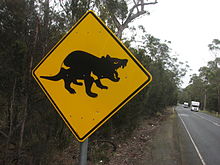 Here’s a logo to send back to the Chinese loggers! Here’s a logo to send back to the Chinese loggers!
.
.
Forestry Tasmania’s ‘Biomass’ Solution
.
Here’s the greenwash spin for biomass by Forestry Tasmania:
‘As governments around the world grapple with global warming, attention is turning to an age old solution – biomass.
Biomass – essentially organic material such as wood from forests or waste material like cattle dung – is one of the oldest sources of energy and is now undergoing a revival as countries look for alternatives to fossil fuels.
The world’s leading countries in renewable energy production, Denmark, Sweden, Finland, the United States and others in Europe are using forest waste in particular to generate electricity.
Forestry Tasmania has been planning for a biomass plant in the south of the state for at least five years. When it developed the investment ready site at Southwood in the Huon Valley, Forestry Tasmania set aside an area for a biomass plant, to generate renewable energy from forestry debris that would otherwise be burnt.
Using our international contacts, we are seeking investors for this exciting project. If successful, we will not only produce more electricity for the state, but reduce greenhouse gases and the amount of smoke generated by forest fires.’
.
[Source: Press Release: ‘Biomass – a new form of renewable energy’, Forestry Tasmania, ^http://www.forestrytas.com.au/regional-dev, retrieved 20110924]
.
But the historical veneer is that once the furnaces are built, like the veneer mills, the multinationals will pressure the Tasmanian government for more fuel and native forests will become fodder for yet another Forestry scheme. Forestry Tasmania knows this and will argue its age old justification of jobs, job, jobs.
 Like all great loggers, I have seen more than I remember, and remember more than I have seen. Like all great loggers, I have seen more than I remember, and remember more than I have seen.
.
.
Further Reading:
.
[1] Seahorses and Chinese Backward Medicine
.
‘In China, seahorses are prescribed from ailments such as asthma, arteosclerosis, dizziness, joint pain, impotence and incontinence. The fact that dried sea horses are consumed for virility is ironic because sea horse are a species in which the males get pregnant.
Seahorse soup “North is ginseng and south is seahorse” is a Chinese adage from the Divine Peasant’s Herbal Compendium. But Chinese have not been the only ones who consumed seahorses as a medicine. The Roman historian Pliny the Elder reported that “ashes of seahorse…mixed with soda and pig’s large” cured baldness.
In Hong Kong, “inferior” seahorses sell for about $100 a pound, Higher quality ones go for around $400 a pound. The seahorses are usually ground and mixed with herbs and other ingredients a made into a tea. An estimated 2 million seahorse were consumed n China in 1992, a tenfold increase from the previous year. Three million wee consumed in Taiwan the same year.
“North in ginseng and south is seahorse” is a Chinese adage from the Divine Pearls Herbal Compendium . In China medicine seahorses are usually ground and mixed with herbs and other ingredients a made into a tea. They are prescribed from ailments such as asthma, atherosclerosis, dizziness, joint pain, impotence and incontinence. The Chinese are not the only people who have used seahorses for medicine. The A.D. first century Roman historian Pliny the Elder reported that “ashes of seahorse…mixed with soda and pig’s large” cured baldness.
Seahorse sales took off in China when the country began opening up in the 1990s. An estimated 2 million seahorse were consumed in China in 1992, a tenfold increase from the previous decade. Three million were consumed in Taiwan the same year. In Hong Kong at that time “inferior” seahorses sold for about $100 a pound. Higher quality ones went for around $400 a pound.
About 25 million of seahorses were harvested every year in the 1990s. About 95 percent of them were sold in Asia for medicines and aphrodisiacs. They are also collected alive for salt water aquarium and sold dried at souvenir shops. In the 1990s their price went up to $800 a pound.
Wild seahorses are caught by hand, with dip nets or as bycatch from shrimp trawlers. Seahorse hunter generally go after their prey at low tide at night, A good hunter can catch 60 a night. Most are dried and sold to middlemen for the Chinese medicine for about 60 cents a piece.
Seahorses are difficult to raise in captivity. They are picky eaters susceptible to disease and die easily. Thus they are difficult to raise commercially and have to be harvested in the wild. Their monogamy doesn’t serve them well. If one loses a partner he or she doesn’t chose another. The company Seahorse Ireland raises seahorses from birth and has had success getting them to mates and breed in captivity. The company sells seahorses for for $2.50 a piece over the Internet.
Seahorses have disappeared from sea grass beds and mangroves from Florida to Ecuador, and on coral reefs from India to Vietnam. Reefs in the Philippines that were once teeming with seahorses are now almost void of them. So many seahorses have been caught that many species are regarded threatened or endangered. Seahorse habitats—coral reefs, grass beds and mangroves—are increasingly under stress from dredges, overfishing, coral dynamiting and pollution.
In 2003 seahorses were declared an endangered species by The United Nations Convention on International Trade on Endangered Species (CITES). An international ban on seahorse trade was imposed unless the captive-bred or used for scientific purposes. In no-fishing zones seahorses have rebounded.’
[Source: ^http://factsanddetails.com/china.php?itemid=331&catid=12]
.
.
[2] ‘Weedy Sea Dragon Protection – 12 April 2011’
.
‘I want to talk this evening about an interesting marine species known as the weedy sea dragon. It is a charismatic mesofauna that members might be interested to know about! Importantly, it is endemic only to southern Australian waters. It is protected everywhere else in Australia from being taken. When I was involved in marine and coastal conservation, particularly with the establishment of the Cottesloe marine protected area, it came to my attention because weedy sea dragons have been seen in that area. One of the reasons for creating that fish habitat–protected area was to encourage that species, amongst others, to thrive in the area and to protect them from recreational activities. They are greatly admired by scuba and snorkel divers because they are very interesting animals to watch. The fact that they are protected elsewhere in Australia actually means that they are inadvertently more likely to be taken here in Western Australia, making them even more vulnerable. The Australian Environment Protection and Biodiversity Conservation Act 1999 lists weedy sea dragons as a nationally threatened species. The International Union for Conservation of Nature lists weedy sea dragons as near-threatened species because of human impacts on the inshore habitat. They are vulnerable because of deteriorating conditions in the inshore habitat, but they are also vulnerable in other ways.
Australia is a signatory to the Convention on International Trade in Endangered Species of Wild Fauna and Flora. The aim of CITES is to ensure that international trade in wild animals and plants does not threaten their survival. In 2002, all seahorse species—the weedy sea dragon is part of the same family—were CITES listed because of concerns over unsustainable exploitation. Members may be aware that they are highly sought after in the Chinese medicine market. There is international concern about how vulnerable this species is. Western Australia, however, still sells them and allows recreational fishers to take threatened weedy sea dragons. Unpublished genetic studies have been carried out on weedy sea dragons, and show that weedy sea dragons west of the Great Australian Bight are actually a separate species, warranting a new name and, in fact, making them even more special. The ones on our side of the southern part of Australia are genetically separate.
The number of weedy sea dragons collected by marine aquarium fishers has decreased in recent years but we are concerned that this may indicate that the population has substantially decreased. We cannot find out from the Department of Fisheries how many there are. It is interesting that collectors want to collect pregnant males for the aquarium industry. Pregnant males are especially sought after under the marine aquarium fishery licences because it is extremely rare for weedy sea dragons to breed in captivity. The fry born from captured pregnant males will sometimes survive in specialist aquaria.
There is great demand for weedies for aquariums, particularly from Sydney and several overseas countries. It is of concern that there are no population figures available for weedy sea dragons and no monitoring is done. Currently, WA has a recreational bag limit of 30 per day. That is of great concern. Weedy sea dragons are sparsely distributed and have very small territories. In fact, they are very territorial. Despite their cryptic nature, some experienced hunters can still find them. A lot of dive operators will not show people where weedy sea dragons are because they are worried that they will come back later and take them for the aquarium trade.
Interestingly, weedy sea dragons are monogamous. If a pregnant male is captured, the female may never breed again. Also, they are very poor swimmers, have specific dietary needs and have a low fecundity. It is a wonder they survive at all. Once these weedy sea dragons are protected, dive and snorkel businesses can develop around them, especially in country WA. As I say, dive operators are presently nervous about showing visitors any animals they find as there have been instances of people returning and collecting them after a guided dive. Owners of the Seahorse Sanctuary in Kalbarri, which members may be aware of, say there is a black market in syngnathids, which is the generic name for this family of animals. This is detrimental to their business. They breed seahorses, not weedy sea dragons. The breeding of seahorses can be done in captivity, but weedy sea dragons do not breed in captivity. Millions of seahorses are traded each year for the Chinese traditional medicine trade. As seahorses are disappearing worldwide because of over-collection, conservationists fear that sea dragons will be targeted for this very lucrative trade. This reason was cited by the South Australian fisheries minister, Rory McEwen, when he announced protected species status for seahorses, pipe fish and weedy sea dragons in South Australia. That was back in February 2006.
Most people are no longer comfortable with creatures being in cages and bowls, especially when they die. This is the case with weedies in the domestic aquaria trade. Weedy sea dragons have become an iconic species, certainly in terms of the conservation sector and dive operators. My concern is that we do not know the population numbers of weedy sea dragons in Western Australia. We have received some conflicting figures from the Department of Fisheries on the estimated population. Weedy sea dragons are vulnerable to changes in their nearshore environment. They are also vulnerable in Western Australia because the taking of them is banned elsewhere in Australia. Therefore, those who have licences to take them in WA have an incentive to do so. What I am saying to the Minister for Fisheries—I am sure he will take note of this—is that there is a very strong case for weedy sea dragons to have protected status in Western Australia as well. I argue that the number of weedy sea dragons taken by the aquarium trade is so low that it is not a substantial economic trade. If we do not know how many of these animals are left, but they have been identified as being under threat, now is the time to prohibit the taking of them. It is much easier to monitor and police a protection order of that nature than to have some system of trying to control and monitor the number taken. That is a very good argument. People value seeing these animals, particularly in the marine protected areas in the metropolitan area, because they are quite extraordinary. It is really important that the minister says that there should be no more taking of these animals. That would be a great bonus for this iconic species that is dearly loved by not just conservationists but also people who enjoy recreational diving.’
.
[Source: ‘Weedy Sea Dragon Protection‘, Giz Watson MLC (Western Australia), 20110412, ^http://www.giz-watson.net/2011/http:/www.giz-watson.net/2011/archives/2011/04/19/weedy-sea-dragon-protection-12-april-2011/]
.
.
 Last Tree Standing Last Tree Standing
‘Exploitation of the foreground.
Identifying the wasteland.
The closest friend.
Promises to the end.
Everyone else is gone.
All possibilities, equal to none?
On one leg, standing.
An insight was landing.’
~ Henrik Malmborg.
[Source: ^http://www.redbubble.com/people/malmborgphoto/art/6969815-last-tree-standing]
.
Tags: a single rider, Amalgamated Zinc, forest death camp, forest rape, Forestry Tasmania, Huon Wood Centre, I am the way and the truth and the life. No one comes to log except through me, I log therefore I am, Last Tree Standing, Leave No Trace, logging Borneo, logging Canada, logging Gabon, logging Oregon, logging Tasmania, logging trucks, logging veneer, Newood, outdoor ethics, Smithton Veneer Mill, southwoodresources, Stairway to Heaven, Ta Ann Group, Tasmanian logging, Triabunna, veneer of truth, Woodchipping Tasmania, Zinc Bargain 1916
Posted in Tasmania (AU), Threats from Deforestation, Threats to Wild Tasmania | No Comments »
Add this post to Del.icio.us - Digg
Thursday, September 22nd, 2011
Like a skin-burned landscape flaking, Tasmania’s disappearing wild forests are revealed on Google Maps. The 19th Century colonial timber-getting landscape around Hamilton in the lighter treeless region on the right of the image. In 2011 the colonial mentality pervades in burnt clearfelled coupes on the left side of the satellite image below. Tasmania’s tall Eucalypt forests and the ecosystems they support face a denuded Hamilton vision or at best a sterile silviculture.
Fourth generation Tasmanian loggers knowing no better, mindlessly scarring their rich timbered homeland for a pittance to feed the profits of multinationals, and knowingly deny their children the endless Tasmanian forests they knew as children. It is Thylacene Bigotry repeated down generations.
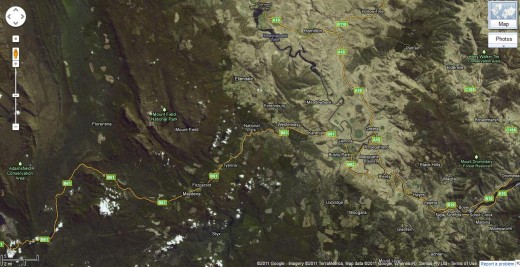 Satellite Map of Tasmania showing vast areas of clearfelled native forest scars.
(Click photo to enlarge)
(Simply go to Google and type in Tasmania Map in Google and zoom in)
.
Satellite Map of Tasmania showing vast areas of clearfelled native forest scars.
(Click photo to enlarge)
(Simply go to Google and type in Tasmania Map in Google and zoom in)
.
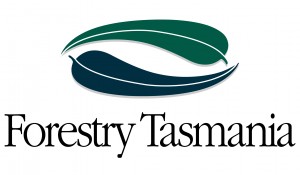
The culprit, Forestry Tasmania (FT), has made it a cliche to hide its destruction from public roads, but can no longer hide from Google Maps.
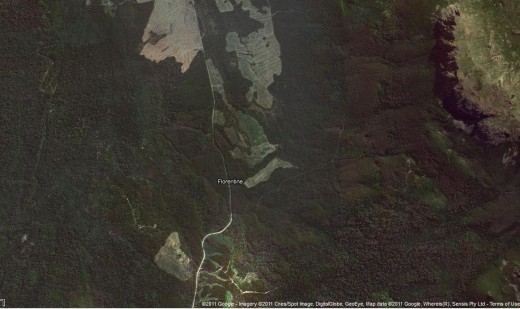 Zooming in on the massive scaring of the Florentine Forest.
(click to enlarge image) Zooming in on the massive scaring of the Florentine Forest.
(click to enlarge image)
(Google Maps)
.
 Zooming in on the massive scaring of the Styx Valley Forest.
(Google Maps) Zooming in on the massive scaring of the Styx Valley Forest.
(Google Maps)
.
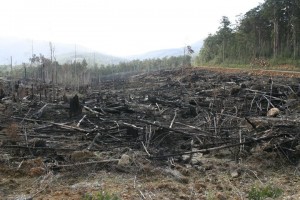
‘This charred scene of forest devastation here in Southern Tasmania stands as a stark symbol of the industrial scale logging operations that are ripping apart Australia’s native forests every single day. Harvey Norman needs to stand up, show some genuine environmental leadership and stop selling native forest products to the Australian people’ said Ms Majewski. [^http://www.thelaststand.org.au/]
[Source: ‘Massive banner unfurled in Tasmania drawing attention to Harvey Norman forest destruction’, by anonymous 20010811, ^http://indymedia.org.au/2011/08/15/massive-banner-unfurled-in-tasmania-drawing-attention-to-harvey-norman-forest-destruction. Watch Video]
.
.
So where does Harvey Norman’s EKO Wood ‘Jatoba’ come from?…
 Jatobá (Hymenaea courbaril)
A tall rainforest hardwood tree common to the Caribbean, Central, and South America.
It is killed for hardwood furniture and flooring.
Go to hell Harvey Norman, go! Jatobá (Hymenaea courbaril)
A tall rainforest hardwood tree common to the Caribbean, Central, and South America.
It is killed for hardwood furniture and flooring.
Go to hell Harvey Norman, go!
.
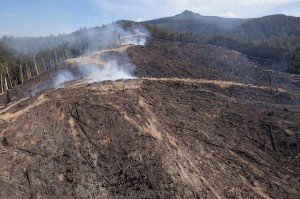
The bastards are clear-felling Tasmania’s majestic Styx Valley in 2011!
Do they hate Tasmania that much?
(Source: ^http://www.thelaststand.org.au/)
(Photo: R. Blakers)
.
..
 Tools of the trade for Forestry Tasmania – Industrial Forestry Bondage – a CAT 553 fellerbuncher- Tools of the trade for Forestry Tasmania – Industrial Forestry Bondage – a CAT 553 fellerbuncher-
But then machines are more efficient than people, and unlike selective logging, with contract woodchipping you don’t have to think ~ ‘its all good’.
Shit Money. Shit Future. Pulping Tasmania’s Heritage so that Jap’s can sell their paper back to us mugs.
(click to enlarge photo)

Husqvarna – ‘taming the wild’ and selling their last chainsaws to a dying culture
– like the Japs killing dolphins at Taijin.
.
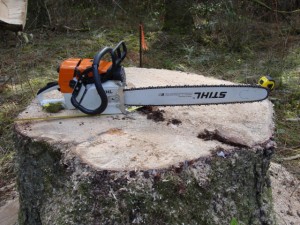 Stihl Chainsawing Tasmania’s Western Front Stihl Chainsawing Tasmania’s Western Front
.
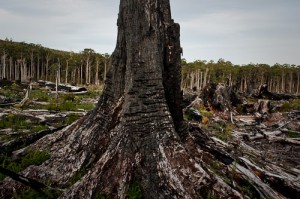 A FT holocaust survivor
. A FT holocaust survivor
.
(‘Holocaust’ comes from the Greek, holos meaning ‘completely’ and kaustos ‘burnt’
~ to burn away, leaving no trace of what was previously there. (A. Krien, 2010, p.122)
.
.
.
.
Tags: CAT 553 Fellerbuncher, EKO Wood, Forestry Tasmania, FT, Google Maps Tasmania Map, Harvey Norman, Husqvarna, Hymenaea courbaril, Industrial Forestry Bondage, Jatoba, Rob Blakers Photography, Stihl, Styx Valley, taming the wild, Tasmania's tall Eucalypt forests, Tasmania's Western Front, The Last Stand, Thylacene Bigotry, Upper Florentine Forest, woodchipping - it's all good, Woodchipping Tasmania
Posted in Tasmania (AU), Threats from Deforestation, Threats to Wild Tasmania | No Comments »
Add this post to Del.icio.us - Digg
Friday, September 9th, 2011

At a time when the Tasmanian Government has a protracted budget crisis, when Gunns and its logging venture is on the brink of financial collapse, and the Australian Federal Government is offering a $276 million package to the Tasmanian logging industry to transition out of subsidy-dependent logging; this is a time for strategic decision making. This is a time for considering the next generation of Tasmanians.
The days of governments providing subsidies to forestry are numbered. The writing is on the wall for multi-national/industrial hardwood forestry in Tasmania.
Despite the less than perfect negotiations, the undemocratic secrecy of the deal making, State and Federal governments’ poor grasp of change management, Tasmanians are presented with an olive branch. The last time a middle-ground opportunity was available to the two warring sides was the 1989 Salamanca Agreement which was quickly scuttled by government. A generation later, a considerable financial incentive and the facilitation of transition out of logging are on the table.
Irreplaceable old growth forest ecosystems are at stake, but equally at stake are rural livelihoods. There are structural social repercussions that will last decades. But then Tasmania’s poverty is already structural. It has become inter-generational and Tasmanians need a transitional direction out of poverty. While mindful of the recurring history of conflict and community polarisation, this current opportunity for change is rare and perhaps a once in a generation one at that.
In order to begin to appreciate the cultural depth of Tasmania’s ‘age-old conflict‘, at least four particular books should be read on this history:
- ‘The South West Book: A Tasmanian Wilderness‘, compiled by Helen Gee,Janet Fenton and Greg Hodge in 1978, published by William Collins Pty Lts and The Australian Conservation Foundation [Read More]
- Helen Gee’s 2001 book ‘For the Forests: A History of the Tasmanian Forest Campaigns‘, published by The Wilderness Society, Inc. [Read More]
- Greg Buckman’s 2008 book ‘Tasmania’s Wilderness Battles: a history‘, published by Allen & Unwin [Read More]
- Anna Krien’s 2010 book ‘Into the Woods: the battle for Tasmania’s Forests‘, published by Black Ink [Read More]
.
Perhaps as an interested outsider, a mainlander, I can consider this Tasmanian-wide conflict from a detached unencumbered perspective. The younger generations have opportunities that their parents and ancestors never did. Had my grandfather not died on the farm when my father was just eight years old, I may well have followed generations into sheep farming. My grandmother with her only child left the farm to give my father the best opportunity she could. I reflect on that opportunity and the greatly increased opportunity that my parents have provided me and my siblings. It takes one opportunity, for others to become available and sometimes it takes generations.
While not setting out to be critical of sheep farming per se, in hindsight sheep farming in Australia over my lifetime has become low margin and commoditised (like woodchips) and many a wool grower have not experienced the anticipated opportunities flowing on from the halcyon days when Australia was built off the sheep’s back. ‘Once a great nation-building icon, the wool business today is but a third of its size when Australia ‘rode on the sheep’s back’. Compared to the more recent Australian Wheat Board scandal, 40 times more funds were lost in the downfall, and vastly more collateral social and economic damage was done in this country and across the globe.’ Indeed, Charles Massey’s 2011 book ‘Breaking the Sheep’s Back‘ tells the untold story of the events that led to Australia’s biggest industry disaster. [Read More].
Just as Australia’s traditional wool business has declined, so too has Australia’s traditional timber business.
‘Most of the change we think we see in life is due to truths being in and out of favor.’
~ Robert Frost’s 1915 poem, ‘The Black Cottage’.
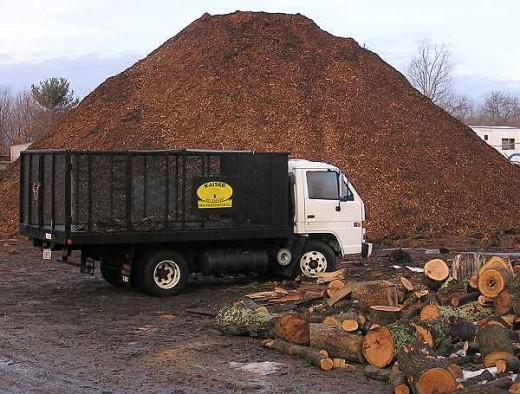 Woodchipping Tasmania only benefits foreign buyers, who must be laughing Woodchipping Tasmania only benefits foreign buyers, who must be laughing
.
Once island problems are recognised for what they are (internal island problems), the quicker more Tasmanian’s will recognise that the future challenges and opportunities of the island lie with industry diversification, value adding produce and services and with the world outside it. Trading internationally directly is where Tasmania’s future prosperity lies. Tasmania can learn much from the pure brand of ‘New Zealand’. Much of Tasmania’s output competes in comparable industries with the output of New Zealand.
Past and current generations of Tasmanians have become familar with old growth forests and many have become complacent of their presence. Future generations have a right to that familiarity.
Tasmanian complacency was the root cultural cause behind the eventual extinction of the Thylacene.
 Extinction is forever ~ the dark past should not curse our future Extinction is forever ~ the dark past should not curse our future
.
“Tasmania is slowly evolving towards goals we cannot now see. If we can revise our attitudes towards the land under our feet; if we can accept a role of steward and depart from the role of conqueror; if we accept the view that man and nature are inseparable parts of a unified whole – then Tasmania can be a shining beacon in a dull, uniform and largely artificial world”.
~ Olegas Truchanas, 1969
[Source: ^http://florentine.org.au/]
.
.
Intergovernmental Forests Agreement, 2011
.
In October 2010, the major breakthrough in the almost century long dispute over Tasmania’s forests was reported secured in principle between the key parties, Tasmanian timber communities, forest unions, and industry, Gunns, Environment Tasmania, the Conservation Council, The Wilderness Society, Australian Conservation Foundation. Credit is due to the two instrumental negotiators, Gunns chief executive Greg L’Estrange and forest facilitator Bill Kelty.
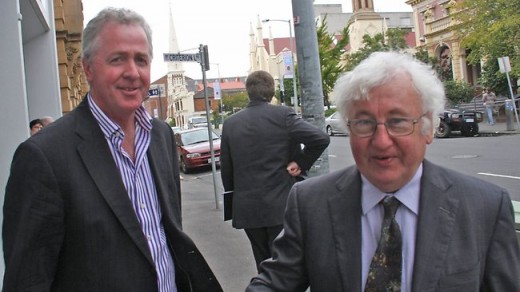 Tasmanian History in the making Tasmanian History in the making
.
The aim was to find an agreement develop a more sustainable timber industry and to end logging Tasmania’s remaining valuable native forests. It will mean an end to logging of native forests will also protect critical habitats for Tasmanian devils and other threatened species. A moratorium on the logging of high native forests will be phased in over three months, while maintaining essential supplies for necessary timber mill operations.
The “Tasmanian Forests Statement of Principles” were agreed to set Tasmania’s timber industry on a new path to economic opportunities through plantation-based forestry, protecting timber worker’s jobs and native forests.
.
.
“The forestry industry, unions and environment groups have found common ground in the interests of all Tasmanians. This will pave the way for a sustainable timber industry that protects jobs and also protects the state’s remaining unique native forests,” said Environment Tasmania’s Phill Pullinger..
.
[Source: ‘Forests: Peace in our time?’, by Andrew Darby, The Age, newspaper, 20101019, ^http://tasmaniantimes.com/index.php/article/peace-in-our-time]
.
.
.
Tasmanian Transition from High Volume/Low to Low Volume/ High Value Add Timber – public debate recommended
.
While not advocating industrial logging of Tasmania’s native myrtle, a refocus from high volume/low margin woodchips toward low volume / high value specialised timbercraft is a Tasmanian industry that has potential to be both commercially viable while being ecologically sustainable, if excluding old growth and so long as it is appropriately tightly controlled and monitored.
A public debate on this potential is recommended.
 High value-add Electric Guitar in Tasmanian Myrtle
[Source: ^http://tasmaniantonewoods.com/guitars] High value-add Electric Guitar in Tasmanian Myrtle
[Source: ^http://tasmaniantonewoods.com/guitars]
.
.
Further Reading:
.
‘Gunns rejects crucial financial offer’
.
[by Andrew Darby, The Age newspaper, 20110906, ^http://www.theage.com.au/national/gunns-rejects-crucial-financial-offer-20110905-1ju9j.html]
.
‘Troubled forestry company Gunns has rejected a financial offer from the Tasmanian government seen as key to the future of the state’s timber industry. The settlement for exiting native forest logging was critical both to Gunns’s future operations and to a landmark forests peace settlement.
”The state government has been formally advised by Gunns Limited of their decision to reject our offer of commercial settlement,” a spokesman for Premier Lara Giddings said yesterday.
The settlement was needed to unlock funding for contractors squeezed by the exit from native forests in a $276 million federal-state package. Rejection comes with Gunns into the fifth week of a stock exchange trading halt, called for the settlement negotiations, with its share price at an all-time low of 20.5¢. The settlement, covering tens of millions of dollars, was meant to extinguish Gunns’s legal rights over native forest contracts with Forestry Tasmania.
.
.
.
‘Tasmanian Forests Agreement (official announcement)’
.
[Source: The Australian Government, 2011, ^http://australia.gov.au/content/tasmanian-forests-agreement]
.
‘The Prime Minister and the Tasmanian Premier have announced a $276 million funding package to support the adjustment of the Tasmanian forestry industry, and to create a significant conservation benefit by reserving and protecting High Conservation Value native forest areas. The Tasmanian Forests Intergovernmental Agreement is designed to support the forest industry to progressively transition to a more sustainable and diversified footing and to build regional economic diversity and community resilience.
The agreement includes:
.
Support for workers, contractors and communities
- Up to $25 million to provide immediate employment and training support for redundant forest workers
- Intensive support through Job Services Australia and other providers relocation support for redundant forestry workers
- $15 million for transition support payments (through ForestWorks)
- $1 million over two years for mental health counselling and community well-being services (through Rural Alive and Well)
- $45 million for voluntary exits from public native forest operations for haulage, harvest and silvicultural contractors.
Tasmanian forest industry workers can call the Tasmanian Forest Support Information Line on 1800 648 075 for more information about the services and payments that may be available to them.
Protecting high conservation value forests and ensuring sustainable wood supply
- Guaranteed annual sustainable timber supply of at least 155,000 cubic metres of high quality sawlog per year and 265,000 cubic metres of peeler billets each year
- Provision for speciality timber, noting that the industry claim is 12,500 cubic metres per year, subject to verification funding to support an independent verification process
- Funding for a voluntary sawlog contract buy-back program for sawmillers wishing to exit the industry
- 430,000 hectares of native forest immediately placed into Informal Reserves
- Legislation no later than 30 June 2012 to formally protect the areas of reserve determined by the independent verification
- $43 million to implement this Agreement (including at least $5 million to support provision of information and consultation with affected communities)
- $7 million per year to support management of additional reserves.
Economic diversification
- $120 million over 15 years to fund regional development projects
- Development of a process to identify by mid 2012:
- the impacts of forestry adjustment on affected regions, including the scope for
- alternative sectors and jobs to support regional adjustment
- progress in implementing Commonwealth and Tasmanian adjustment measures
- the need for further regional development assistance
- A major research and analytical project to underpin this process.
.
.
‘Giddings acts to avert budget crisis’
[Source: Brand Tasmania Newsletter, March, 2011, Issue 114, ^http://www.brandtasmania.com/newsletter.php?ACT=story&issue=114&story=1]
 Tasmanian Premier and Treasurer, Lara Giddings
Photo courtesy of The Hobart Mercury
Tasmanian Premier and Treasurer, Lara Giddings
Photo courtesy of The Hobart Mercury
.
As unemployment figures for January showed a monthly rise from 5.0 to 5.6 %, the Premier and Treasurer, Lara Giddings, foreshadowed a 3 % cut in public sector spending and warned Tasmanians to expect three tough Budgets as the State’s balance sheet is shifted back into the black.
Releasing the Mid Year Financial Report on 10 February, Ms Giddings said several 2010 elections promises would have to be scrapped in the drive to off-set an $800 million loss of revenue. She outlined the following immediate savings:
- $97.5m cancellation of equity transfers to GBEs;
- $30.9m scrapping of planned Helicopter Emergency Medical Service;
- $18.0m shelving of proposed Cosgrove Specialist Sports School;
- $ 3.8m dropping of the Events Attraction Program;
- $ 2.0m closing down the Renewable Energy Loan Fund
- $ 3.9m deferring IT projects over two years; and
- $ 2.5m cutting ministerial and parliamentary office expenditure.
“These savings will improve the Government’s financial position in the short term while longer-term structural changes are being developed and implemented,” Ms Giddings said.
She told a media conference the savings needed were the equivalent of 2,300 jobs and she could not rule out forced redundancies in the public service, nor cuts to frontline services. Unions immediately branded her as the first Labor Premier in history to announce public service sackings.
.
“I want to be open and frank with people about the problems we are facing,” Ms Giddings said.
“We are in a place where we need to see significant action to avert a crisis. This is not a crisis; this is an unsustainable situation that will lead to a crisis if action isn’t taken now.”
.
[Editor’s note:
To the contrary, a ‘crisis‘ in a governmental context is defined by the Merriam-Webster dictionary as:
“an unstable or crucial time or state of affairs in which a decisive change is impending; especially : one with the distinct possibility of a highly undesirable outcome <a financial crisis>“]
.
The number of people on the State Government payroll has increased 24 per cent this decade to 25,000 – almost one in every nine employed Tasmanians. Economic commentator Saul Eslake has pointed out that it costs public employees 14 per cent more a year to deliver services to each citizen, compared with their counterparts in Victoria.
So the Government expects job cuts, spending cutbacks and increased efficiency in the public service to contribute $270 million of the $420 million it hopes to save over the next four years.
Ms Giddings said it was regrettable that some worthwhile Government programs could not be continued, but strong action was needed in response to falls in GST revenue and other income in the wake of the global financial crisis. “I am determined to take the steps necessary to protect the Government’s financial position,” Ms Giddings said. “While I would prefer not to have to take some of these measures, I believe they are essential if we are to avoid sliding back into net debt.”
A Sensis Business Index released in late February reinforced the need for decisive action, Ms Giddings said. “The national downturn in retail trade is a concern the State Government shares with local retailers, as it continues to directly impact upon the State budget through reduced GST receipts.”
.
[ Read More]
.

– end of article –
.
Tags: Bill Kelty, Forest Reserve Map, high conservation value forests, Intergovernmental Forest Agreement, Tasmanian Budget Crisis, Tasmanian complacency, Tasmanian Forests Statement of Principles, Tasmanian logging, Woodchipping Tasmania
Posted in Tasmania (AU), Threats from Deforestation, Threats to Wild Tasmania | No Comments »
Add this post to Del.icio.us - Digg
Friday, July 29th, 2011
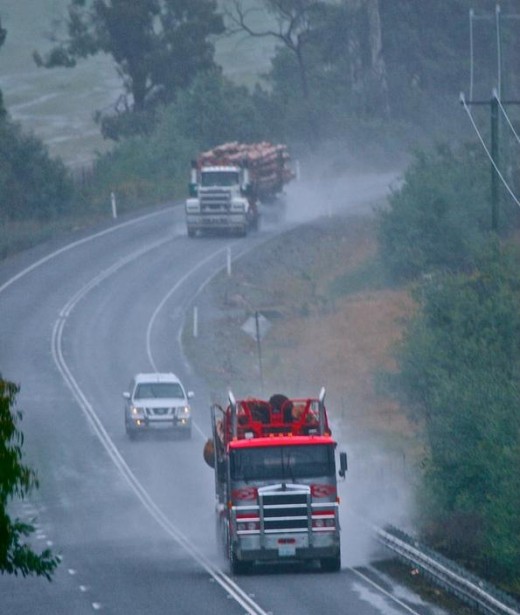 Trucks Logging Tasmania
© Photo by Paul Tapp, Triabunna, Tasmania, 20110718
[Source: http://tasmaniantimes.com/index.php/article/the-triabunna-experiment] Trucks Logging Tasmania
© Photo by Paul Tapp, Triabunna, Tasmania, 20110718
[Source: http://tasmaniantimes.com/index.php/article/the-triabunna-experiment]
.
‘A peace deal between Tasmania’s forestry industry and environmental lobby has been secured by a $274 million government package, raising hopes the long-running conflict is near an end.
.
‘The deal hammered out at the weekend by the Prime Minister, Julia Gillard, and the Tasmanian Premier, Lara Giddings, has the full backing of industry but was criticised by green groups.
The deal ensures existing major logging contracts can be met from forests outside the protected areas but halves the key sawlog quota. The package confirms the reservation of 430,000 hectares of native forest around the state, including the Tarkine rainforests of the island’s north-west and ‘a sprinkling of mountainous coastal forests around the east coast’.
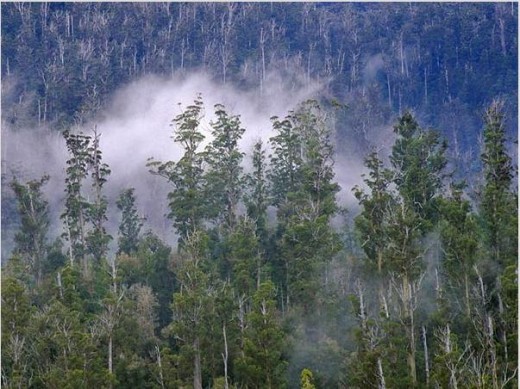
‘With the lion’s share of funds to come from the Commonwealth, the package’s big-ticket items are $85 million to workers and contractors who lose their jobs in industry restructuring, $120 million in extra regional development money for Tasmania and $43 million to implement the changes.
‘The strategically important Triabunna woodchip mill, bought by wealthy environmentalists Jan Cameron and Graeme Wood last week, is to keep operating. But its chips will need Forest Stewardship Council certification, meaning an end for the mass woodchipping of old growth that so divided Tasmania.
‘But one of the chief negotiators, Phill Pullinger of Environment Tasmania, said critical points still lay ahead in translating the weekend’s federal-state heads of agreement into a fully operational process.
‘The federal Greens leader, Bob Brown, said the agreement was a ”Labor-Labor-loggers‘‘ outcome.
”The popular expectation that a 610,000 hectare system of wild forest national parks would be established, as the loggers were bailed out of their failing industry, has been dashed.”
.
[Source: ‘ $274m buys hope that bitter logging dispute is at an end‘, by Andrew Darby, The Age newspaper, Hobart, 20110725]
Read more: ^http://www.theage.com.au/environment/conservation/tasmania-in-274m-forests-deal-20110724-1hves.html
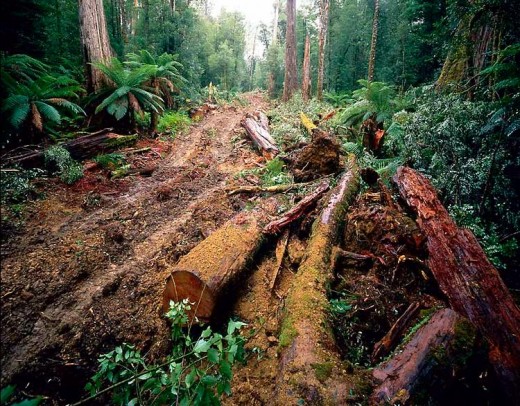 A Forestry Tasmania Footprint
© Photo by Rob Blakers Photography, www.RobBlakers.com A Forestry Tasmania Footprint
© Photo by Rob Blakers Photography, www.RobBlakers.com
http://www.water-sos.org/rob-blakers1.html
‘There has always been good reason to preserve Tasmania’s native old-growth forests. But two years ago the bitter, protracted conflict between loggers and conservationists took a decisive turn.
‘Scientists at the Australian National University revealed that the moist, cool forests of south-eastern Australia are the most carbon-dense environments in the natural world. They store on average more than twice the carbon per hectare than moist, tropical rainforests, which are a more familiar focus of global environmental concerns. Then in May this year, Australia’s new Climate Commission identified the preservation of these forests as critical in limiting Australia’s emissions “while the slower process of transforming energy and transport systems unfolds“.
‘Likewise, the commission estimated billions of tonnes of carbon could be sequestered from the atmosphere if logged areas were reafforested. Add to that the novel intervention of two entrepreneurs who recently paid $10 million for a Gunns sawmill – just so they could close it down – and it seems the three-decade-old impasse over Tasmania’s native forests has finally been broken.
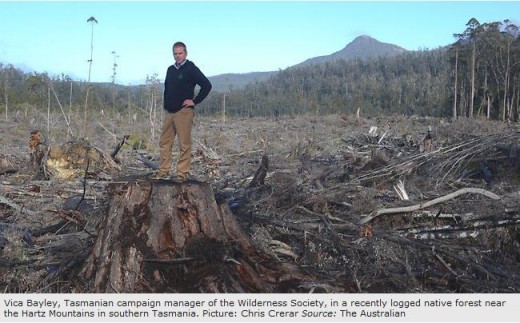
‘This weekend’s $274 million federal government package, which puts 430,000 hectares of native forests off-limits to loggers, is a historic first step. True, the deal between environmentalists and the timber industry is a compromise and not everyone is happy. But the agreement does recognise two crucial claims: the urgent need to protect native forests from further commercial encroachment and the legitimate demand for compensation from communities that have long lived from logging. Tasmania’s small regional economy is vulnerable, which is partly why logging, and the jobs it supports, have long been such a divisive issue. Equally, the dispute has been deadlocked for want of an alternative vision.
‘Globally, forest clearing is responsible for 18 per cent of greenhouse gas emissions. With a carbon tax coming in Australia and numerous carbon trading schemes already operating around the world, such extraordinary carbon sinks as Tasmania’s old-growth forests now have an economic value, not just an ecological one.
‘At the same time, the competitiveness of Tasmania’s woodchip industry has been declining because of the high Australian dollar and low-cost plantations elsewhere. Tasmania’s green credentials have been compromised by images of protesters chained to trunks and of magnificent, ancient trees being felled to satisfy the world’s appetite for woodchips, pulp and disposable chopsticks.
‘Australia’s smallest state should now be able to position itself favourably for the low-carbon economy of the future. That does not rule out supplying high-quality, high-value timber sourced from “certified sustainable” plantations to an environmentally discerning local and global market.’
.
[Source: ‘Old-growth valued at last‘, Sydney Morning Herald, Editorial, 20110725, p.10]
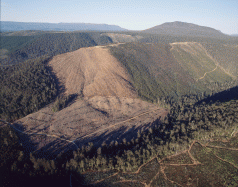 © Photo by Rob Blakers © Photo by Rob Blakers
.
.
Editor’s comment:
.
Government bail out of a 19th Century exploitative industry with taxpayer millions is expedient short term politics ~ throwing other people’s money at the problem. The Labor Gillard Government has just pitched a $274 million bail out package to Forestry Tasmania and its dependents, but as usual the devil is in the detail. That funding is stretched over ten years and is split between the Federal and Tasmanian governments. It seems only $85 million is being made available from Gillard’s bail out in the current year. Her press release (copy below) is unclear on this. Moreover, while $85 million is welcome to Tasmanians, at the same time as Premier Lara Giddings announced recently, Tasmania has been denied a total of around $1.5 billion in expected GST revenue and State taxes from the Federal Government. Tasmanian revenues are being controlled by Canberra. Canberra is treating Tasmania as a welfare state, and a welfare state is what Tasmania is becoming.
.
Twenty-first Century leadership for Tasmania requires triple-bottom line innovative problem solving, listening to all the people of Tasmania.
.
It is incumbent on Tasmanians themselves to strategise a long term competitive and independent vision for Tasmania’s economy and society that respects Tasmania’s natural values. Twenty-first Century political leadership would see the national government encourage this, facilitate a transition process (and not deny GST funding) to trust and enable the island elected Tasmanian Government itself to implement the transition strategies as it sees fit. The transition process demands a quantum investment in vocational education of Tasmanians. So where is that strategy?
.
The crux of Tasmania’s triple bottom line problem in all this is that ‘Tasmania’s small regional economy is vulnerable!’
.
Overhaul and nurture Tasmania’s regional employment to ‘certified sustainability’, since only then may Tasmania’s regional social and ecological systemic problems be resolved with broad community support.
.
In the editor’s view, Tasmania has sufficient natural resources, clean-green industries and innovative entrepreneurs to give New Zealand and its ‘pure’ brand image a run for its money. Tasmania’s natural and human capital just need to be tapped, nurtured and professionally marketed…globally.
.
The following extracts provide some background reading in this issue. Readers can make up their own minds.
.
.
Background Reading:
.
What is the Tasmanian Government’s strategy?
.
Start with the lead agency, termed the ‘Tasmanian Planning Commission’
.
Well it seems its strategy is mainly about urban development. “The current main strategic national priorities are:
- Capital city strategic planning
- Development assessment reform
- Housing affordability
- Climate change (however that is dealt with)
- Retail competition.”
.
What the hell is the Tasmanian Planning Commission’s terms of reference, or is there some other entity delegated to consider Tasmania’s ‘whole of island’ planning?
READ MORE: ^http://www.planning.tas.gov.au/the_planning_system/national_planning
.
.
…meanwhile…’Prime Minister’s press release on the future of ‘Tasmanian Forestry’, 20110724
.
‘Australian and Tasmanian Governments support the future of Tasmanian forestry‘, Sunday 20110724, jointly by the Prime Minister and Premier of Tasmania
[Source: ^http://www.pm.gov.au/press-office/australian-and-tasmanian-governments-support-future-tasmanian-forestry]
.
‘Prime Minister Julia Gillard and Tasmanian Premier Lara Giddings today announced an historic agreement on the future of forestry in Tasmania. In the face of changing market conditions, both in Australia and around the world, it has become clear that the pressure on the Tasmanian forestry industry in its current form is not sustainable. Today’s agreement will secure jobs, ensure a sustainable forestry industry, and achieve iconic environmental outcomes by protecting High Conservation Value forests and remaining old growth forests for future generations.The Heads of Agreement, backed by up to $276 million, will also support workers and their families affected by industry restructure.
Under the Heads of Agreement:
- The Australian and Tasmanian Governments will provide up to $85 million in immediate assistance for workers and contractors who are losing their jobs and livelihoods as a result of industry restructure. This will include employee assistance, retraining and relocation support and assistance for voluntary permanent exits from native forest operations for haulage and harvest contractors (what to?);
- Facilitate sustainable opportunities for the Tasmanian forestry sector with the Tasmanian Government guaranteeing at least 155,000 cubic metres per year in wood supply, 12,500 cubic metres per year of speciality timbers, subject to verification and 265,000 cubic metres of billets, with existing wood supply contracts to be honoured and the Australian Government to fund a voluntary exit mechanism to enable further native wood supply capacity to be retired and reserve areas increased when suitable plantation wood supply is available;
- The Tasmanian Government will reserve and protect 430,000 hectares of native forest from within the 572,000 hectares nominated through the Statement of Principles process, and place the full 572,000 in informal reserve subject to an independent verification process of conservation values and compatibility with yearly guaranteed wood supply, led by Professor Jonathan West. The findings will determine the area of High Conservation Value forest to be reserved, with $7 million a year for their ongoing management to be provided by the Australian Government following incorporation into formal reserves;
- $120 million in Australian Government investment over 15 years, including $20 million in 2011-12, to develop and diversify the Tasmanian economy to drive new job opportunities for Tasmanian families, including through job-creating projects (such as?) in communities affected by forestry restructure. A new ministerial advisory council to be chaired by Mr Bill Kelty AC will drive new regional development opportunities and a new place-based investment Memorandum of Understanding (MoU) between the two governments; and
- The Australian Government will provide $43 million to implement the Heads of Agreement including funding for a range of activities such as working with communities through the transition and provide voluntary compensable exits to sawmillers wishing to exit the native forestry industry.
.
The Heads of Agreement is consistent with the Statement of Principles agreement between environment non-government organisations, the Tasmanian forestry industry and the CFMEU, which was presented by independent facilitator Mr Bill Kelty last month.
It means the forestry industry can continue on a sustainable footing, and guarantees ongoing supply for existing businesses that are critical to supporting jobs and regional communities in Tasmania.The Australian and Tasmanian Governments thank the signatories to the Statement of Principles and Mr Kelty for their commitment and hard work. The Statement of Principles process and the Heads of Agreement reached today creates an opportunity to move forward after decades of conflict and build a stronger future for Tasmania.Governments recognise the significant challenges faced by the industry in the face of global economic and market conditions as well as the historic opportunity provided by forestry and environmental parties coming together to agree on a framework for delivering a sustainable future for the forest industry and the environment. We also recognise that these challenges, as well as the decision by Gunns Limited to exit from native forestry, will have significant impacts on workers, communities and the Tasmanian economy.The Governments clearly expect that following today’s historic agreement environment and industry stakeholders will end the long-running conflict over native forestry. The Governments also expect that the Tasmanian Parliament will pass the required legislation by 30 June 2012. The Australian and Tasmanian governments will work together to identify and support regional economic development through a partnership to create investment and jobs opportunities, particularly for regional communities..
The Australian and Tasmanian Governments will also work together to examine and identify potential opportunities from increased reserves from the Commonwealth Biodiversity Fund. In October last year, the Tasmanian forestry industry and several environmental non-government organisations reached a Statement of Principles for protecting native forests and developing a sustainable timber industry in Tasmania. The Australian and Tasmanian Governments appointed Mr Bill Kelty as an independent facilitator to facilitate talks on the Statement of Principles agreed to between environment non-government organisations, the CFMEU and the forestry industry in Tasmania.’
.
.
…meanwhile…’Independent Strategic Review of Forestry Must Examine Auditor-General’s Report’
by Kim Booth MP, Greens Member for BassKim Booth MP, Greens Forestry spokesperson, Wednesday, 20110706
[Source: ^http://mps.tas.greens.org.au/2011/07/independent-strategic-review-of-forestry-tasmania-must-examine-auditor-general%E2%80%99s-report-and-no-further-public-bail-out-without-parliaments-approval/]
.
‘The Tasmanian Greens today called on the Minister for Forests to ensure that the current independent Strategic Review into Forestry Tasmania includes the Auditor-General’s Special Report 100, Financial and economic performance of Forestry Tasmania, saying that the Report makes it clear that Forestry Tasmania is a failed business and in urgent need of restructure..
Greens Forestry spokesperson, Kim Booth MP, also called for a commitment that no further public monies will be used to bail out Forestry Tasmania from any financial difficulties without such a funding injection first coming before the Parliament.
“I have long been on the record warning the Minister that Forestry Tasmania is a rogue agency that has been unable to return a sustainable commercial rate of return for the Tasmanian public, and is in fact a drain upon the public purse,” Mr Booth said.
“As Shareholder Minister, it is incumbent on him to take responsibility for the fact that the Auditor General formed the view that whilst the ‘expectation of Forestry, and the environment in which it operates, changed fundamentally’ over the last 15 years, the ‘business and funding model did not keep pace with these changes.”
“This Report by the Auditor-General is relevant to the independent Strategic Review of Forestry Tasmania, and the Greens believe it must be formally submitted for the Review’s consideration.”
“With Forestry Tasmania crying poor and the suggestion that more public money might be required to pay their employees superannuation how will the Minister reassure Tasmanians that he will take a more active role in ensuring hard-earned public money is not thrown into the bottomless pit that is Forestry Tasmania?”
“Any further injection of public funds, to bail out this underperforming GBE, should not occur without first seeking Parliament’s approval of any conditions set upon which public money is provided,” Mr Booth said.’
.
.
…meanwhile…’What the community thinks of the forest peace talks’
Media release by Forestry Tasmania, 20110724.
[Source: ^http://www.forestrytas.com.au/news-room/media-releases/what-the-community-thinks-of-the-forest-peace-talks].‘Forestry Tasmania has this morning released a new opinion poll to provide negotiators with an insight into what the community expects out of the forest peace talks.Managing Director Bob Gordon said the survey conducted by respected pollster EMRS for Forestry Tasmania was to his knowledge the only attempt by any of the parties to gain a credible gauge on the community’s expectations and its results therefore could be useful as the Federal and State governments edge closer to a final agreement.
“Finding a durable long lasting agreement that embraced the community’s wishes was always going to be a challenge, and that is reflected in the survey results. The survey found the community wants to strike a balance between environmental outcomes and jobs. When asked to nominate important outcomes, nearly two thirds mentioned protecting old growth forests while 60 per cent nominated jobs. It also found the community overwhelmingly believed that any additional reserves should be determined by rigorous scientific analysis, while less than one in five people thought the State should simply agree to the request by environmentalists to lock up (read ‘save’) 572,000 hectares. It is therefore reasonable to conclude that any agreement must include independent verification of the so called high conservation value forests, if it’s to win community acceptance.”
Mr Gordon said governments also had a communications challenge ahead. “More than half of respondents did not believe they had sufficient information to make an informed decision about the peace talks.”
The EMRS survey of 600 people in late June was part of an ongoing series of tracking surveys that FT has commissioned since August 2008. Mr Gordon said he was delighted that Forestry Tasmania’s reputation had remained strong during a period of considerable turmoil.
“FT’s rating as a good corporate citizen had slipped slightly, but 56 percent had a positive perception of FT compared to 28 per cent with a negative view. “This particular survey indicates there has been a significant shift in community expectations since the previous survey 12 months ago. The community is becoming more concerned about employment and the economy. For example, the percentage of those wanting FT to focus on creating jobs was now at its highest level since March 2009. On the other hand, the percentage of those wanting carbon to be the highest priority had dropped from 30 per cent two years ago to just 13 per cent now.”
.
.
…meanwhile…’Tasmania – $111 million better off with Forestry Tasmania’
Media Release by Forestry Tasmania, 20110722
[Source: ^http://www.forestrytas.com.au/news-room/media-releases/tasmania-111-million-better-off-with-forestry-tasmania]
..
‘Forestry Tasmania has launched a new television advertising campaign highlighting the contribution made by the timber industry to rural Tasmania.The new commercial was shot in Geeveston featuring local workers earlier this week and goes to air for the first time tonight. Forestry Tasmania’s Managing Director Bob Gordon said the commercial draws heavily on the recently released Auditor General’s report into FT’s financial and economic performance, which found Tasmania was $111 million a year better off with Forestry Tasmania operating.
“This report debunks the myth peddled by anti forestry activists that FT and the native forest industry is heavily subsidised and Tasmania would be better off without it. “The fact is the future of many rural and regional communities would be at risk if there was a sudden halt to native forestry. Forestry is the life blood of many, many country towns in Tasmania, and already many are suffering as a result of the forestry downturn.”
Mr Gordon said the $111 million referred to by the Auditor General was conservative.
“Last year, the final value of products produced from state forest timber was $563m – and that’s in a year where forestry was dealing with its worst downturn in memory. That $563m supported in the vicinity of 3,000 full time direct jobs. There are many more workers that indirectly depend on the income from forestry – in retail, hospitality, transport and service sectors. “It’s important to remember that the $111m is just FT’s contribution, it doesn’t include the contribution of the local sawmiller, the local contractor, veneer mills and furniture makers that rely on the wood products harvested from State forests. The full value of the timber industry is around $1.4billion.”
Mr Gordon said FT had committed $14,000 in airtime for the new commercial.
“I’m not going to apologise for spending that money on keeping the community informed and our brand healthy. Too many people depend on FT maintaining a good, strong reputation for us to become squeamish about spending dollars on advertising.”
FT will soon release the results of its latest EMRS poll, measuring corporate brand. The results show FT remains one of the most respected brands in Tasmania, remaining ahead of eight other key businesses and GBE’s.
“Community support for the work we do is still very strong, but this poll is significant because jobs are emerging as the number one issue. People still want a balance between development and the environment, but they think the balance has tipped too far in favour of green ideology, and not enough emphasis is being placed on jobs, particularly in rural and regional communities.”
.
.
…meanwhile…’Step forward for Tasmania’s forests’
Media release by The Wilderness Society (Tasmania), 20110725
[Source: ^http://www.wilderness.org.au/regions/tasmania/step-forward-for-tasmanias-forests]
.
After a campaign lasting more than three decades, the end is now closer than ever in the battle to protect Tasmania’s unique native forests.
With the Prime Minister and Premier Giddings finally coming to the negotiation table, the full implementation of last year’s forest agreement is now in sight. Back in May this year, we suspended our involvement in the Tasmanian forest talks. This was due to inaction by both the Federal and Tasmanian Governments in implementing the forest agreement that was signed by environment groups and the timber industry in October 2010. Now the two governments have finally shown the leadership we have been calling for and the implementation of the historic agreement can now begin.
“This is an important day in the history of the 30-year battle to save Tasmania’s magnificent forests,” said Wilderness Society Tasmania Campaign Manager Vica Bayley.
While the full Statement of Principles has not yet been implemented, this is a major step forward. The next steps in the process will be crucial to bringing a lasting peace in the forests.
Sunday’s signing of the Heads of Agreement between the Federal and Tasmanian Governments maps out a process to immediately protect 430,000 hectares of high-conservation value native forests, with a further 142,000 hectares set aside from logging and awaiting protection subject to verification processes.
The agreement also includes $128 million to assist logging companies and contractors to exit the industry. We will continue to work with other environment groups, unions, the timber industry and both governments to ensure all 572,000 hectares of high-conservation value native forests are protected within world heritage areas and national parks.
The proposed Tamar Valley pulp mill is not part of this latest announcement and the Wilderness Society remains opposed to its construction.
.
.
…meanwhile… back to the subject of Strategies for Tasmania…this is what Tasmania’s leader is focusing on:
.
‘Ministerial Statement: Tasmanian State Services Structural Reforms and Productivity Strategies’
by Lara Giddings Labor Premier of Tasmania
[Source: ^http://www.premier.tas.gov.au/hot_topics/ministerial_statement_-_tasmanian_state_service_structural_reforms_and_productivity_strategies, no date]
.
Introduction
“Mr Speaker, on the 10th of February I released the Mid-Year Financial Report.
The Report detailed the significant financial challenge we face in framing this year’s State Budget. Since then, we have heard in the Federal Budget that Tasmania will lose a further $343 million in GST receipts. That means we have now lost a total of around $1.5 billion in expected GST revenue and State taxes from the Forward Estimates.
Mr Speaker, we are faced with some difficult decisions to ensure we do not go back to the bad old days of the 1990s, when we had spiralling debt, and when we saw funds that should have been spent on services instead being used to pay the interest on that debt. I am determined not to allow the State Budget to slide back into that situation. How we will achieve that will be in next month’s Budget.
But today I want to announce some of the approaches the Government will be taking to help us to return the State’s finances to a sustainable footing while improving the productivity of the public service
In releasing the Mid Year Financial Report, I said the Government would implement a Public Sector Productivity Strategy, with the aim of achieving savings of around $200 million per annum by 2014 15.
Today I will give more detail about some of the ways we will achieve that. Our first priority has been to look at reducing expenses that do not impact on employment, such as phones, cars, travel and the like, but of course those things alone will not be enough to reach our savings target.
In simple terms, the measures I will announce fall into two broad categories. The first set is about making our public service more productive and more efficient The second set is about reducing the cost of our public sector. Both are critical if we are to restore the State Budget to a sustainable footing. The Government’s response to our Budget challenge is not about slashing costs just for the sake of it.
It is about returning the Budget to surplus so we can continue to invest in jobs and services that will ensure Tasmania remains a great place to live. It is about making the right decisions today so we can have a better future.
Mr Speaker, I am aware of the anxiety created in the public service by the Government’s need to find savings.
I know there are many hard working and dedicated public servants who are worried about how these changes might affect them. It is unfortunate that this period of uncertainty has been unavoidable as we work through the issues around the Budget. It is also disappointing that some have chosen to fill the vacuum while we were formulating our response with fear campaigns and misinformation.
In the meantime I have been discussing our approach with key stakeholders, unions, heads of agencies and my Labor and Green colleagues. I hope to be able to allay some of the concerns that have arisen by making it clearer how we will go about making those changes.
That is one reason that I have brought this announcement forward to today rather than leaving it to Budget day next month: so that people will know more about what is happening – and what is not – sooner rather than later.
I value the contribution of our public servants, and indeed strong public services are at the very core of Labor values such as equity, fairness and helping those most in need.
Mr Speaker, I will first outline to the House some of the measures we will be taking to achieve the productivity changes I spoke about – how we will go about achieving greater flexibility and efficiency.
This approach is about making the state service more contemporary, less bureaucratic and more accountable, with a more agile and productive workforce to meet future needs of the Tasmanian community.
Once I have done that I will outline the processes we will follow to reduce our costs. I will not be outlining the exact savings we will be making – that is an issue for next month’s budget.
But I will talk about the process we will follow to ensure employees are treated as fairly, flexibly, compassionately and openly as possible if their positions are identified as no longer being required. The reality is that employee salaries and associated costs make up over 50% of operational expenditure, and in some Agencies this percentage is as high as 70%. Savings in recurrent expenditure of the magnitude that we require can only be achieved through prioritising programs and achieving savings in Agency employment costs.
I have said repeatedly since I released the Mid Year Financial Report that redundancies, and particularly involuntary redundancies, would be a last resort. The measures I announce today are consistent with that approach and will maximise the opportunity for those affected to find new jobs with minimal disruption to their lives.
But where redundancies are required these reforms will ensure affected staff are treated fairly through a clearly understood process. Two of these measures will require legislative change but in large part they are entirely consistent with existing powers and processes
Although they will not be part of the Budget legislation, I will be asking members to agree to the necessary amendments to the Tasmanian State Service Act during the Budget session.
.
Independent State Service Review
Mr Speaker, one of the key steps we will take to address the productivity of our public sector relates to the longer term governance arrangements that should apply to State Service employment.
The State Service Act 2000 underpins all employment in the State Service and establishes governance, employment and structural arrangements for the Tasmanian State Service.
It is time to review these arrangements to guarantee the State Service remains able to meet the challenges of the future.
There are concerns about some aspects of the current arrangements including:
- The clarity of lines of authority
- Support for contemporary workforce management, which allows for flexibility to respond to service delivery, program or policy changes; and
- The number of jurisdictions involved in appeals and reviews (e.g. State Service Commissioner, Tasmanian Industrial Commission, Integrity Commission, Anti-Discrimination Commission).
Mr Speaker, these are concerns that have been raised with me in my discussions with unions, agencies and other key stakeholders and I believe we must address them if we are to make our public sector the best it can be.So today I announce that the Government will commission, through our usual procurement processes, an independent review to examine:
- Employer role responsibilities
- The State Service Commissioner role and responsibilities
- Head of Agency roles and responsibilities
- Tasmanian Industrial Relations Commission roles
- Appropriate grounds of appeal and the correct jurisdiction to determine appeals.
This review will involve consultation and discussion with all stakeholders, including staff, unions and other relevant bodies. In addition the reviewer will be asked to provide recommendations and propose a way forward which may involve amendments to the State Service and Industrial Relations Acts.
State Service Amendment (Performance) Bill 2011
Mr Speaker, improving productivity is essential if we are to maintain a high level of service in the key front line areas – like health, emergency management and education – on which we all depend.Following consultation with agencies and key unions, the Government has determined that performance management, including dealing with underperformance, is a critical component of a Tasmanian State Service “reform agenda” to improve the efficiency and productivity of our public sector.It was also accepted that an authority is required within the legislation to enable us to assist those employees who are struggling or unable to perform the tasks required of them. Most of us want to know if we are not performing to the expectations of our employer, and we need to be given the feedback and the opportunity to improve.It is the Government’s duty as a responsible employer to work with staff to ensure they can perform to the best of their ability, which is good for their morale and career prospects, and obviously a boost for productivity and the quality of service we provide to the public.
We have a responsibility to strengthen our performance management processes, including better training for managers, and indeed that is an issue that unions have raised with me as a way of ensuring staff are given the feedback they need and deserve.
In response, I will be introducing the State Service Amendment (Performance) Bill 2011 to amend the State Service Act 2000 to enable more active management of both performance and underperformance of state service employees.
The amendments will also provide a proper authority for the termination of those employees who after support is given are still unable to perform their duties effectively. It is important that this legislation be introduced at this time to distinguish between this and processes involving surplus employees.
These changes are not a ‘backdoor’ way of sacking people to reduce costs. They are about ensuring our public sector is working efficiently and effectively and providing taxpayers with value for their money. But if at the end of the day some individuals cannot meet those expectations we need a fair and open process to work through.
The provisions of the amendment will ensure that agencies adhere to “due process” (natural justice) in cases involving termination and provide authority to the Minister administering the State Service Act to ultimately, after due process, terminate employment of under-performing employees.
.
Workforce Renewal Incentive Program
Mr Speaker, I have already announced the implementation of a Workforce Renewal Incentive Program.
This program provides an incentive (of up to $20,000) to allow staff to separate from the State Service in certain circumstances, and gives us the opportunity to gain new skills and capabilities in the workforce.
The Program will allow Agencies to renew their workforce and maintain a balanced workforce profile to meet their priority objectives.
The Workforce Renewal Incentive Program is about ensuring the State Service has the right skills profile to meet the challenges of 2011-12 and beyond.
This approach has already been successfully implemented in the Education Department, allowing us to help renew the teaching profession and provide more opportunities for graduates.
.
Vacancy management
Mr Speaker, I now want to turn to the reforms that relate to reducing the cost of our public service.
These changes go to the processes we will follow in seeking to reduce our costs, and how we will attempt to minimise the disruption to the affected individuals in the process.
It is clear that we will not be able to maintain public service employee numbers at the current levels – it’s just not sustainable. Recognising this situation, the Government will put in place a range of measures designed to support Agencies in managing reductions in employee numbers.
As I have consistently said, redundancies will be the last resort. And if we do have to offer redundancies, they will be targeted and limited to positions that are no longer required. We will not be offering mass redundancies because they are too costly and they are not strategic.
Invariably when you open redundancies to anyone who wants to go you lose skills and experience that you did not want to lose. So, if we identify that a position is no longer required the first step we will take will be to see if the person in that position can be redeployed to a vacancy within their own agency.
Each agency has already implemented internal vacancy management measures. These will ensure that each position that becomes vacant will be fully reviewed before any recruitment process is started to determine:
• If it is essential for the position to be filled;
• If the classification level of the position is appropriate; and
• If there are any surplus employees within the agency able to fill the position.
Internal agency vacancy management also encompasses other strategies such as:
• the timing of filling the vacancy;
• the ability of the position to be filled on part-time or job-sharing basis;
• natural attrition following normal separation (abolition of funded vacancies);
• restructuring within Agencies where programs or services are to be discontinued;
• reviewing the need for specific fixed term employment;
• reassignment of duties to existing employees (within the Agency);
• increased approval of leave without pay applications;
• increased approval of secondments to organisations outside the State Service (where available);
• increased use of flexible working arrangements, such as part time employment; and/ or
• workforce re-profiling and utilisation of the Workforce Renewal Incentive Program that I mentioned earlier.
.
Inter-agency vacancies
Mr Speaker, if a member of staff who is surplus to requirements cannot be redeployed within their own agency the next step will be to see if their skills can be used in another agency.
I will be issuing a Ministerial Direction that details procedures to manage inter-agency vacancies. The Direction will ensure that there is a whole of government approach to matching surplus employees with vacancies that exist across all agencies.
It is essential that there is a consistent and coordinated approach to these strategies and the Public Sector Management Office (PSMO), within the Department of Premier and Cabinet is to be the single contact point for matching surplus employees and vacancies.
Where a Head of Agency is unable to identify suitable vacancies within the agency, he or she may recommend to the independent State Service Commissioner, who will oversee the process, that an employee be made available for redeployment in accordance with section 47 of the State Service Act 2000.
In the case of a Senior Executive Service (SES) officer, the Secretary of DPAC is advised.
Employees and officers accepted as surplus may be considered on a suitability basis for transfer to vacant state service positions in other agencies. Assessments of suitability will be undertaken by assessment panels established by agencies for that purpose. The purpose of a suitability assessment is to determine whether the referred employee/officer can satisfactorily carry out the duties either immediately or within a reasonable time given appropriate training and experience.
.
External placement of surplus employees
Mr Speaker, the next step if staff who are no longer required cannot be redeployed within government will be to see if we can assist them to find work externally.
The Public Sector Management Office will explore career or specific job opportunities external to the Tasmanian State Service for surplus employees and officers, including permanent and fixed term placements. The terms and conditions of any external placement will be negotiated with the relevant parties in accordance with Section 46 of the State Service Act.
PSMO will also establish a schedule of preferred providers that may be available to assist surplus employees. These will include, but not be limited to:
• Career Planning;
• Outplacement;
• Job search;
• Counselling (Employee Assistance Program);
• Financial management;
• Superannuation; and
• Taxation
Agencies may refer surplus employees at any time to the above support services and will, in consultation with their employees, decide the appropriate provider, type and level of advice to assist the employee.
Targeted voluntary redundancy arrangements
Mr Speaker, the Government is currently reviewing its targeted voluntary redundancy arrangements, and I would hope that these, combined with our vacancy control and redeployment measures, will help to minimise the need for any involuntary redundancies.
As I have already said, the emphasis of these arrangements will be on specific targeted redundancies within identified programs, rather than a general offer of voluntary redundancies across a range of program areas, as has been the previous approach.
This will better align our voluntary redundancy arrangements with the structural reform and productivity strategies required to meet our Budget task.
The renewed arrangements will also be designed to:
• place greater onus on Heads of Agency to consider and exhaust other options before offering voluntary redundancies;
• ensure greater emphasis on justifying the cost/benefit of voluntary redundancies before offers are made;
• improve flexibility by incentivising redundancies where other alternatives have been exhausted and early voluntary separation is both desirable and cost effective; and
• minimise the need for involuntary separations.
Changes to Section 47
Mr Speaker, currently the Tasmanian State Service Act provides for a twelve month redeployment period for employees declared as surplus under Section 47.
After much discussion within Government and Cabinet this period was considered to be too long. The Government did consider moving to a three month period but it was agreed that this was too short to allow all options for employees to be redeployed to be explored.
As a result, the Government intends to introduce an amendment to section 47 of the State Service Act which will limit the maximum redeployment period to six-months.
Some other jurisdictions do not specify any redeployment period for surplus employees, though they do require genuine attempts to be made to redeploy surplus employees before termination occurs.
Industrial precedent and decisions in Industrial Tribunals require that an employer demonstrate that redeployment attempts have not been successful, or are not available.
A six-month period is reasonable for inter-agency and alternative strategies to be properly explored. In some cases, particularly for an employee with highly-specialised skills and employment needs, the likelihood or otherwise of redeployment would be established well within this timeframe.
A six-month period appropriately balances redeployment requirements and the costs of continued employment. A longer period of uncertainty also has a negative impact on the employee and the workforce generally.
.
Involuntary redundancies
Mr Speaker, once all of the options I have detailed have been exhausted the very last step we may be forced to take is involuntary redundancies.
I can inform the House that the Government will not be seeking to amend Section 44 of the State Service Act to allow for involuntary termination on economic and operational grounds.
I recognise that some stakeholders were concerned that we might have chosen this path because they feared it could lead to widespread and abrupt redundancies without the type of redeployment options and voluntary processes I have spoken about today. This was an issue of particular concern to unions and my Labor and Greens colleagues.
Instead, if required we would seek to achieve the savings required through the existing provisions of Section 47 of the current State Service Act, which was introduced in 2000 by the Bacon Labor Government.
Section 47 provides for termination after it is has been declared that suitable redeployment has not been available through the various processes I have detailed. Previously, it has been unclear under Section 47 whether an involuntary redundancy package should be made available after this declaration is made.
To ensure there is no longer any doubt, the Government has agreed that, should this stage be reached, after the opportunity has been given to take a voluntary redundancy or pursue redeployment options over six-months, the affected employee will be entitled to a redundancy package.
This package should reflect a balanced and reasonable approach based on the need for “fair” treatment of our employees while recognising the financial benefit that accrues through having had a guaranteed six month paid redeployment period.
The package will contain a minimum payment consistent with the Targeted Voluntary Redundancy Arrangements. The package will also contain a ‘years of service’ payment.
The difference between the package for a ‘voluntary offer and acceptance’ and an involuntary redundancy will need to take into account the benefits that accrue to an employee who remains on redeployment for the full 26-weeks.
We will finalise the details of the involuntary redundancy entitlements following further discussion and consultation with the Unions.
Conclusion
In conclusion, Mr Speaker, the current fiscal situation means the Government is no longer able to meet its budget targets, and we risk moving into an unsustainable position if action is not taken.
Improving the efficiency and productivity of the state service, and reducing our costs, are key strategies we will be implementing in the coming months. But this is also about strengthening our public sector so it can better perform its key role – providing services to the Tasmanian community.
It is important to remember that the majority of employees will not be affected by decisions that identify programs that are no longer required. But I am very conscious that the changes we need to make should be done fairly and openly so we can minimise concerns among staff and the impact on the affected individuals.
That is why I have detailed today the measures we will be implementing and the processes we will be following, and I will ensure that all of our public servants are made aware of what we will be doing.
And I hope that by releasing more details about the direction we will be taking we can allay some of the concerns and fears that have arisen in recent weeks, and we will continue to work with staff and unions as we work through this process.
I believe these changes will lead to a more productive and efficient public service. They will reduce the Government’s costs at a time of financial pressure, and they will do so in a way that gives affected staff the best chance of finding alternative employment. And for employees who find themselves in areas where the positions they occupy are no longer required, it is critical that the alternatives available to them should be fair and clear.
I believe the range of measures I have announced today will help us to achieve all of these goals as we negotiate the difficult times ahead.”
.
.
– end of article –
Tags: certified sustainable, Environment Tasmania, forest peace talks, Forest Stewardship Council certification, Forestry Tasmania, Gunns, Julia Gillard, Lara Giddings, logging trucks, old growth, Phill Pullinger, sawlog quota, Strategies for Tasmania, Tasmania welfare state, Tasmania's old-growth forests, Tasmanian logging, Tasmanian Planning Commission, The Wilderness Society, Triabunna, wildtasmania.org, Woodchipping Tasmania
Posted in Tasmania (AU), Threats from Deforestation, Threats to Wild Tasmania | No Comments »
Add this post to Del.icio.us - Digg
|
|
 Miranda – Defender of Tasmania’s Forest Heritage
at the foot of ‘The Observer Tree‘
Mount Mueller Forest, Styx Valley, Tasmania
Miranda – Defender of Tasmania’s Forest Heritage
at the foot of ‘The Observer Tree‘
Mount Mueller Forest, Styx Valley, Tasmania Tasmania’s Forest Wars
– what the Intergovernmental Agreement is supposed to resolve.
Tasmania’s Forest Wars
– what the Intergovernmental Agreement is supposed to resolve.
 Giddings and Gillard
– hollow Labor promises
Giddings and Gillard
– hollow Labor promises

 Styx Valley Giants being massacred by State logger ‘Forestry Tasmania’
Styx Valley Giants being massacred by State logger ‘Forestry Tasmania’
 ‘El Grande’
Australia’s largest tree burned to death in 2003 by Forestry Tasmania’s incompetence
‘El Grande’
Australia’s largest tree burned to death in 2003 by Forestry Tasmania’s incompetence
 ‘Observer Tree’ location
^http://observertree.org/2011/12/15/observertree-on-google-maps/
‘Observer Tree’ location
^http://observertree.org/2011/12/15/observertree-on-google-maps/
 Google Earth’s satellite image of the Observer Tree in dense old-growth, adjacent to Forestry Tasmania’s fresh logging road
(click photo to enlarge)
Google Earth’s satellite image of the Observer Tree in dense old-growth, adjacent to Forestry Tasmania’s fresh logging road
(click photo to enlarge)
 Close up image
(click photo to enlarge)
Close up image
(click photo to enlarge)
 Directing the logging – Forestry Tasmania’s Steve Whiteley
[Source: Southern Cross Television, 20111214]
Directing the logging – Forestry Tasmania’s Steve Whiteley
[Source: Southern Cross Television, 20111214]
 Logging Nazi in and destroying the Styx Valley Forest
Monday 12th December 2011, in direct breach of Prime Minister Gillard’s Forest Agreement.
Logging Nazi in and destroying the Styx Valley Forest
Monday 12th December 2011, in direct breach of Prime Minister Gillard’s Forest Agreement.
 Walter E. Kurtz – unhinged, his methods unsound.
Walter E. Kurtz – unhinged, his methods unsound.



















 Get out of my bloody way!
It’s logging season and they could change the laws next week!
Get out of my bloody way!
It’s logging season and they could change the laws next week!


























